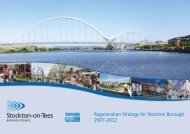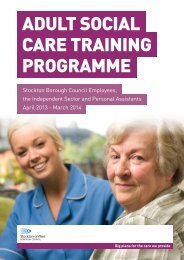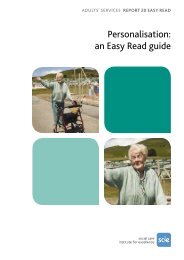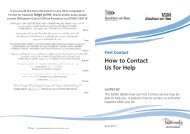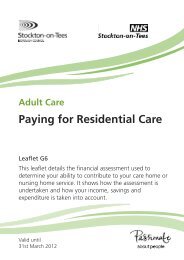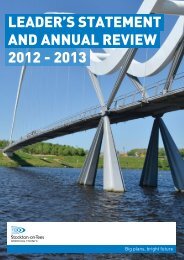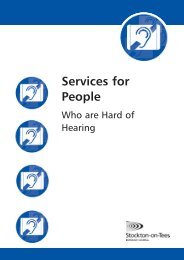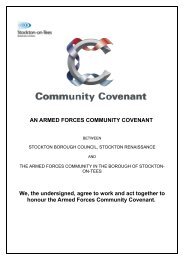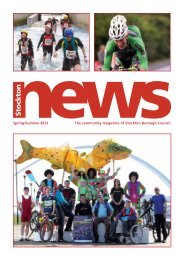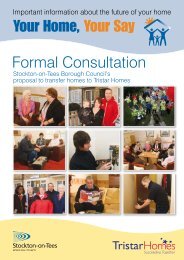View the Local Account document - Stockton-on-Tees Borough ...
View the Local Account document - Stockton-on-Tees Borough ...
View the Local Account document - Stockton-on-Tees Borough ...
You also want an ePaper? Increase the reach of your titles
YUMPU automatically turns print PDFs into web optimized ePapers that Google loves.
Are You Being<br />
Served... Well?<br />
Adult Social Care<br />
Services in 2011/12<br />
The ‘<str<strong>on</strong>g>Local</str<strong>on</strong>g> <str<strong>on</strong>g>Account</str<strong>on</strong>g>’ for <str<strong>on</strong>g>Stockt<strong>on</strong></str<strong>on</strong>g>-<strong>on</strong>-<strong>Tees</strong><br />
Adult Services<br />
Big plans for <str<strong>on</strong>g>the</str<strong>on</strong>g> care we provide
Foreword<br />
Welcome to <str<strong>on</strong>g>Stockt<strong>on</strong></str<strong>on</strong>g>’s first ‘<str<strong>on</strong>g>Local</str<strong>on</strong>g> <str<strong>on</strong>g>Account</str<strong>on</strong>g>’ of Adult Social Care services, covering<br />
2011/12.<br />
This is an opportunity to share with you how we are working to improve social care<br />
outcomes for our adult populati<strong>on</strong>, how we have resp<strong>on</strong>ded to what you have said<br />
about our services and what our plans are for <str<strong>on</strong>g>the</str<strong>on</strong>g> future. Our <str<strong>on</strong>g>Account</str<strong>on</strong>g> includes what<br />
has been achieved with our key partners, including <str<strong>on</strong>g>the</str<strong>on</strong>g> Voluntary and Community<br />
Sector, Health and o<str<strong>on</strong>g>the</str<strong>on</strong>g>r parts of <str<strong>on</strong>g>the</str<strong>on</strong>g> Council.<br />
This report has been produced in a background of changes in <str<strong>on</strong>g>the</str<strong>on</strong>g> way that <str<strong>on</strong>g>the</str<strong>on</strong>g><br />
effectiveness of our support services are judged. As well as external inspecti<strong>on</strong> and<br />
assessment <str<strong>on</strong>g>the</str<strong>on</strong>g>re is now a greater emphasis <strong>on</strong> improving local accountability for <str<strong>on</strong>g>the</str<strong>on</strong>g><br />
way that services are performing and developing. The publicati<strong>on</strong> of a ‘<str<strong>on</strong>g>Local</str<strong>on</strong>g> <str<strong>on</strong>g>Account</str<strong>on</strong>g>’<br />
is an important element in engaging local people and ensuring that services c<strong>on</strong>tinue<br />
to meet people’s needs and make a real difference to <str<strong>on</strong>g>the</str<strong>on</strong>g>ir lives.<br />
You may be aware that we have had to make some difficult decisi<strong>on</strong>s <strong>on</strong> funding<br />
services. Our current priorities have been shaped by what local people are saying<br />
about what services should look like. This report will provide <str<strong>on</strong>g>the</str<strong>on</strong>g> opportunity for us to<br />
show how we are taking forward <str<strong>on</strong>g>the</str<strong>on</strong>g>se priorities:<br />
• Safeguarding<br />
• Pers<strong>on</strong>alisati<strong>on</strong><br />
• Preventi<strong>on</strong> and Early Interventi<strong>on</strong><br />
• Carers.<br />
The first three of <str<strong>on</strong>g>the</str<strong>on</strong>g> priorities, as listed above, have been <str<strong>on</strong>g>the</str<strong>on</strong>g> subject of significant<br />
change during 2011/12. Carers services have recently underg<strong>on</strong>e a major review<br />
which will result in similar changes and investment during 2012/13.<br />
As a result, we are reporting <strong>on</strong> our performance against a background of significant<br />
change. Although this represents a challenge, we feel that it is important that we tell<br />
<str<strong>on</strong>g>the</str<strong>on</strong>g> story of why we are changing what we do, what we have achieved and what we still<br />
have to do. This transparency provides an envir<strong>on</strong>ment for h<strong>on</strong>est dialogue and<br />
debate <strong>on</strong> <str<strong>on</strong>g>the</str<strong>on</strong>g> shape of future services.<br />
We have adopted <str<strong>on</strong>g>the</str<strong>on</strong>g> title ‘Are You Being Served.....Well?’ for our first <str<strong>on</strong>g>Local</str<strong>on</strong>g> <str<strong>on</strong>g>Account</str<strong>on</strong>g>.<br />
This is in recogniti<strong>on</strong> of <str<strong>on</strong>g>the</str<strong>on</strong>g> importance of events such as those held with local people<br />
<strong>on</strong> <str<strong>on</strong>g>the</str<strong>on</strong>g> future of services for older people. Similar events and o<str<strong>on</strong>g>the</str<strong>on</strong>g>r ways of<br />
commenting <strong>on</strong> services will increasingly become central to <str<strong>on</strong>g>the</str<strong>on</strong>g> producti<strong>on</strong> of this<br />
report <strong>on</strong> an annual basis. We are already looking at how this will work for 2012/13.<br />
Page 1
In <str<strong>on</strong>g>the</str<strong>on</strong>g> meantime, please tell us of your experiences of adult services and anything that<br />
needs to improve. The ways of c<strong>on</strong>tacting us are detailed at <str<strong>on</strong>g>the</str<strong>on</strong>g> back of this <str<strong>on</strong>g>document</str<strong>on</strong>g>.<br />
Cllr Jim Beall<br />
Deputy Leader & Cabinet Member<br />
for Adult Services & Health<br />
Page 2
C<strong>on</strong>tents<br />
About Adult Social Care in <str<strong>on</strong>g>Stockt<strong>on</strong></str<strong>on</strong>g>-<strong>on</strong>-<strong>Tees</strong> 4<br />
1 What do people think about our services? 6<br />
2 How do we deliver value for m<strong>on</strong>ey? 10<br />
3 Funding our priorities 13<br />
4 How our key priorities are improving outcomes 14<br />
4.1 Keeping Vulnerable Adults Safe (Safeguarding) 14<br />
4.2 Carers 20<br />
4.3 Pers<strong>on</strong>alisati<strong>on</strong> 23<br />
4.4 Preventi<strong>on</strong> and Early Interventi<strong>on</strong> 36<br />
5 Our plans for improving services 33<br />
6 Our public informati<strong>on</strong> services/C<strong>on</strong>tacting us 36<br />
Page 3
About Adult Social Care in <str<strong>on</strong>g>Stockt<strong>on</strong></str<strong>on</strong>g>-<strong>on</strong>-<strong>Tees</strong><br />
Adult Social Care Services are resp<strong>on</strong>sible for assessing people’s needs for social<br />
care support and helping to arrange <str<strong>on</strong>g>the</str<strong>on</strong>g> services to meet <str<strong>on</strong>g>the</str<strong>on</strong>g> agreed care needs which<br />
will be set out in a care plan – for example, supporting discharge from hospital, help<br />
at home, or getting out during <str<strong>on</strong>g>the</str<strong>on</strong>g> day, or breaks for carers.<br />
People are assessed against ‘Fair Access to Care’ criteria which help to determine if<br />
adult social care support can be offered and how much people may have to pay for <str<strong>on</strong>g>the</str<strong>on</strong>g><br />
services and support required. People who do not meet <str<strong>on</strong>g>the</str<strong>on</strong>g>se criteria may still get<br />
advice and help to find support from independent and voluntary services in <str<strong>on</strong>g>the</str<strong>on</strong>g><br />
community.<br />
We also offer people pers<strong>on</strong>al budgets which we can ei<str<strong>on</strong>g>the</str<strong>on</strong>g>r manage <strong>on</strong> <str<strong>on</strong>g>the</str<strong>on</strong>g>ir behalf to<br />
arrange services for <str<strong>on</strong>g>the</str<strong>on</strong>g>m; or <str<strong>on</strong>g>the</str<strong>on</strong>g>y may choose to manage <str<strong>on</strong>g>the</str<strong>on</strong>g>ir own budgets and<br />
make <str<strong>on</strong>g>the</str<strong>on</strong>g>ir own arrangements for <str<strong>on</strong>g>the</str<strong>on</strong>g>ir care.<br />
Assessment of needs is carried out by care management teams who work closely with<br />
o<str<strong>on</strong>g>the</str<strong>on</strong>g>r agencies, especially health services, to ensure <str<strong>on</strong>g>the</str<strong>on</strong>g> required care arrangements<br />
are put in place and are reviewed regularly. A Commissi<strong>on</strong>ing team arranges<br />
c<strong>on</strong>tracts with a range of organisati<strong>on</strong>s in <str<strong>on</strong>g>the</str<strong>on</strong>g> private, voluntary and community<br />
sectors who provide social care services; and m<strong>on</strong>itors <str<strong>on</strong>g>the</str<strong>on</strong>g> quality of <str<strong>on</strong>g>the</str<strong>on</strong>g> work <str<strong>on</strong>g>the</str<strong>on</strong>g>se<br />
services carry out.<br />
Page 4
Some facts and figures for 2011/12:<br />
• Adult Care services were provided to 7,555 clients.<br />
• 2,125 new clients were assessed for care packages.<br />
• 509 clients were provided with short term interventi<strong>on</strong>s e.g. intermediate care and<br />
reablement, to enable independent living.<br />
• 2,436 clients were provided with equipment or adaptati<strong>on</strong>s to support <str<strong>on</strong>g>the</str<strong>on</strong>g>m in <str<strong>on</strong>g>the</str<strong>on</strong>g>ir<br />
own home.<br />
• 330 permanent admissi<strong>on</strong>s were made to residential care.<br />
Our changing populati<strong>on</strong>:<br />
By 2030 it is predicted that:<br />
• There will be a 58% increase in <str<strong>on</strong>g>the</str<strong>on</strong>g> 65+ populati<strong>on</strong> (<str<strong>on</strong>g>the</str<strong>on</strong>g> proporti<strong>on</strong> of people aged<br />
65+ in <str<strong>on</strong>g>Stockt<strong>on</strong></str<strong>on</strong>g>-<strong>on</strong>-<strong>Tees</strong> will be greater than that in England as a whole).<br />
• The proporti<strong>on</strong> of <str<strong>on</strong>g>the</str<strong>on</strong>g> total populati<strong>on</strong> aged 85+ will almost double (this will still be<br />
smaller than for England, but <str<strong>on</strong>g>the</str<strong>on</strong>g> gap will be narrower than at any time in <str<strong>on</strong>g>the</str<strong>on</strong>g><br />
preceding 25 years).<br />
• There will be a relatively greater increase in <str<strong>on</strong>g>the</str<strong>on</strong>g> proporti<strong>on</strong> of males living l<strong>on</strong>ger.<br />
• The number of people with a learning disability will more than double over <str<strong>on</strong>g>the</str<strong>on</strong>g> next<br />
10 years.<br />
Some implicati<strong>on</strong>s of this change:<br />
• The prevalence of dementia will increase – proporti<strong>on</strong> of 65+ populati<strong>on</strong> predicted<br />
to have dementia will increase by over 80%.<br />
• Over half of <str<strong>on</strong>g>the</str<strong>on</strong>g> 65+ populati<strong>on</strong> will have a limiting l<strong>on</strong>g-term illness.<br />
• A relatively greater proporti<strong>on</strong> of people aged 65+ will be living al<strong>on</strong>e (predicted to<br />
be 6,000 more).<br />
Page 5
Secti<strong>on</strong> 1<br />
What people think about Adult Social Care<br />
What our Service Users say about our services<br />
Your feedback <strong>on</strong> <str<strong>on</strong>g>the</str<strong>on</strong>g> services we provide is important to us. It gives <str<strong>on</strong>g>the</str<strong>on</strong>g> informati<strong>on</strong><br />
required to make fur<str<strong>on</strong>g>the</str<strong>on</strong>g>r improvements to services and make a real difference to<br />
people’s lives. We collect this feedback from a number of sources and this secti<strong>on</strong><br />
sets out some of <str<strong>on</strong>g>the</str<strong>on</strong>g> key messages we have received during 2011/12 and any acti<strong>on</strong>s<br />
we have taken as a result.<br />
During 2011/12 we took part in a nati<strong>on</strong>al Adult Social Care Survey. This was <str<strong>on</strong>g>the</str<strong>on</strong>g> first<br />
of what is to be an annual survey designed to develop an understanding of how<br />
services are affecting people’s lives. The results of this survey provide an important<br />
snapshot of how services have been received and what has been achieved. Over time<br />
we will be able to look at trends and benchmark what people are saying locally with<br />
results from o<str<strong>on</strong>g>the</str<strong>on</strong>g>r councils.<br />
We sent out 1200 questi<strong>on</strong>naires to people from all user groups who receive our<br />
services. The resp<strong>on</strong>se rate of 36.6% was high for such surveys and meant that <str<strong>on</strong>g>the</str<strong>on</strong>g><br />
results were valid. What people told us is summarised below:<br />
• 92% of resp<strong>on</strong>dents felt quite, very or extremely satisfied with <str<strong>on</strong>g>the</str<strong>on</strong>g> service <str<strong>on</strong>g>the</str<strong>on</strong>g>y<br />
receive. The equivalent figure for people with a learning disability was 98% (this<br />
being <str<strong>on</strong>g>the</str<strong>on</strong>g> percentage who stated that <str<strong>on</strong>g>the</str<strong>on</strong>g>y were happy with <str<strong>on</strong>g>the</str<strong>on</strong>g> service).<br />
• 82% resp<strong>on</strong>ded that <str<strong>on</strong>g>the</str<strong>on</strong>g> support <str<strong>on</strong>g>the</str<strong>on</strong>g>y received helped <str<strong>on</strong>g>the</str<strong>on</strong>g>m to have a better quality<br />
of life.<br />
• 80% stated that <str<strong>on</strong>g>the</str<strong>on</strong>g>y had adequate or as much c<strong>on</strong>trol of <str<strong>on</strong>g>the</str<strong>on</strong>g>ir or lives as <str<strong>on</strong>g>the</str<strong>on</strong>g>y<br />
would wish. The remaining 20% stated that <str<strong>on</strong>g>the</str<strong>on</strong>g>y had not enough or no c<strong>on</strong>trol.<br />
When we asked about <str<strong>on</strong>g>the</str<strong>on</strong>g> role of services in c<strong>on</strong>tributing to <str<strong>on</strong>g>the</str<strong>on</strong>g>m having c<strong>on</strong>trol<br />
over <str<strong>on</strong>g>the</str<strong>on</strong>g>ir lives <str<strong>on</strong>g>the</str<strong>on</strong>g> split was about <str<strong>on</strong>g>the</str<strong>on</strong>g> same. This underlines <str<strong>on</strong>g>the</str<strong>on</strong>g> importance of<br />
ensuring we do more to implement our plans for pers<strong>on</strong>alisati<strong>on</strong> as a means of<br />
giving people more c<strong>on</strong>trol over <str<strong>on</strong>g>the</str<strong>on</strong>g>ir lives.<br />
• 94% of resp<strong>on</strong>dents felt safe or adequately safe and 60% felt that care services<br />
c<strong>on</strong>tributed to <str<strong>on</strong>g>the</str<strong>on</strong>g>m feeling safe. Our plans for safeguarding and community safety<br />
will impact <strong>on</strong> how safe people feel.<br />
• 45% of resp<strong>on</strong>dents received help <strong>on</strong> a regular basis from some<strong>on</strong>e in <str<strong>on</strong>g>the</str<strong>on</strong>g>ir<br />
household. 50% received help <strong>on</strong> a regular basis from some<strong>on</strong>e living in ano<str<strong>on</strong>g>the</str<strong>on</strong>g>r<br />
household. These results underline <str<strong>on</strong>g>the</str<strong>on</strong>g> importance of supporting carers who<br />
provide such crucial support to so many people receiving our services.<br />
Page 6
During 2011/12 we also c<strong>on</strong>ducted a local survey of 230 people who use our services,<br />
to see how satisfied <str<strong>on</strong>g>the</str<strong>on</strong>g>y were with our social work services and <str<strong>on</strong>g>the</str<strong>on</strong>g>ir treatment<br />
during <str<strong>on</strong>g>the</str<strong>on</strong>g> assessment process. Overall <str<strong>on</strong>g>the</str<strong>on</strong>g> level of satisfacti<strong>on</strong> was very positive:<br />
• 98% of resp<strong>on</strong>dents expressed overall satisfacti<strong>on</strong> with <str<strong>on</strong>g>the</str<strong>on</strong>g> outcome of <str<strong>on</strong>g>the</str<strong>on</strong>g>ir<br />
assessment.<br />
• People were generally satisfied with <str<strong>on</strong>g>the</str<strong>on</strong>g> speed of our resp<strong>on</strong>se, how <str<strong>on</strong>g>the</str<strong>on</strong>g>y were<br />
treated and listened to and our explanati<strong>on</strong> as to what would happen next.<br />
One helpful learning point from this survey was <str<strong>on</strong>g>the</str<strong>on</strong>g> importance of ensuring our<br />
service users have clear informati<strong>on</strong> about what to do if <str<strong>on</strong>g>the</str<strong>on</strong>g>y have any c<strong>on</strong>cerns or<br />
complaints about <str<strong>on</strong>g>the</str<strong>on</strong>g> service. This is something we are taking into account in our<br />
procedures for staff when assessing people for services.<br />
You Said: We Did ................. ‘Are You Being Served’<br />
Are You Being Served’ was an event for <str<strong>on</strong>g>the</str<strong>on</strong>g> over 50’s held in October 2011. Over 200<br />
people attended this event where a panel of service leaders answered questi<strong>on</strong>s <strong>on</strong><br />
a variety of topics developed through group discussi<strong>on</strong>s. We will run this and similar<br />
events in future years in order to provide feedback <strong>on</strong> our services for this report.<br />
You Said<br />
A number of questi<strong>on</strong>s were asked of <str<strong>on</strong>g>the</str<strong>on</strong>g> panel covering services such as <str<strong>on</strong>g>the</str<strong>on</strong>g> Police,<br />
Community Protecti<strong>on</strong>, Public Health, Adult Social Care, Fire and Ambulance<br />
Services.<br />
We Did<br />
Publish a newsletter c<strong>on</strong>taining written resp<strong>on</strong>ses to many of <str<strong>on</strong>g>the</str<strong>on</strong>g> questi<strong>on</strong>s asked<br />
<strong>on</strong> <str<strong>on</strong>g>the</str<strong>on</strong>g> day. As well as making <str<strong>on</strong>g>the</str<strong>on</strong>g>se available to those attending <str<strong>on</strong>g>the</str<strong>on</strong>g> day, copies<br />
were placed in libraries and o<str<strong>on</strong>g>the</str<strong>on</strong>g>r main c<strong>on</strong>tact points throughout <str<strong>on</strong>g>the</str<strong>on</strong>g> <strong>Borough</strong>.<br />
The outcome was that not <strong>on</strong>ly were older people better informed about services<br />
and <str<strong>on</strong>g>the</str<strong>on</strong>g> partnerships which exist in <str<strong>on</strong>g>Stockt<strong>on</strong></str<strong>on</strong>g> but, importantly, <str<strong>on</strong>g>the</str<strong>on</strong>g> feedback was<br />
used by providers to shape services.<br />
Page 7
Independent inspecti<strong>on</strong><br />
The Care Quality Commissi<strong>on</strong> (CQC), <str<strong>on</strong>g>the</str<strong>on</strong>g> independent arm of government resp<strong>on</strong>sible<br />
for regulating <str<strong>on</strong>g>the</str<strong>on</strong>g> quality of health and care providers, assessed and inspected adult<br />
care services until 2010.<br />
• In our last CQC annual assessment, issued in January 2011, our adult care<br />
services were assessed as ‘performing well’ overall.<br />
• In July 2010, our adult care services received a detailed inspecti<strong>on</strong>, with a<br />
particular focus <strong>on</strong> safeguarding adults, increasing choice and c<strong>on</strong>trol for older<br />
people, and leadership and commissi<strong>on</strong>ing. The inspecti<strong>on</strong> judged that we were<br />
‘performing well’ in relati<strong>on</strong> to safeguarding adults, and increasing choice and<br />
c<strong>on</strong>trol for older people. We were also judged to have “promising capacity to<br />
improve” in relati<strong>on</strong> to leadership and commissi<strong>on</strong>ing.<br />
The role of CQC has now changed, as <str<strong>on</strong>g>the</str<strong>on</strong>g> Government has moved away from its<br />
previous emphasis <strong>on</strong> formal inspecti<strong>on</strong> and assessment. Instead a sector led<br />
approach is being promoted which will be underpinned by rigorous self-assessment<br />
al<strong>on</strong>gside a process of peer challenge, support and review. As part of this new<br />
approach councils will publish a local performance report, <str<strong>on</strong>g>the</str<strong>on</strong>g> <str<strong>on</strong>g>Local</str<strong>on</strong>g> <str<strong>on</strong>g>Account</str<strong>on</strong>g>, as a<br />
means of promoting transparency and engaging local people in service improvement.<br />
Using Comments, Commendati<strong>on</strong>s and Complaints<br />
It is important that people feel able to tell us of <str<strong>on</strong>g>the</str<strong>on</strong>g>ir experiences of our services, both<br />
positive and negative, and we operate a Comments, Commendati<strong>on</strong>s and Complaints<br />
procedure to allow this to happen. We accept that when things do not go well our<br />
complaints procedure is a vital part of putting things right.<br />
Our complaints procedure covers all adult social care services, whe<str<strong>on</strong>g>the</str<strong>on</strong>g>r <str<strong>on</strong>g>the</str<strong>on</strong>g>se are<br />
provided directly or purchased from <str<strong>on</strong>g>the</str<strong>on</strong>g> independent sector. It does not cover services<br />
people pay for <str<strong>on</strong>g>the</str<strong>on</strong>g>mselves using a direct payment or pers<strong>on</strong>alised budget but it does<br />
cover any issues relating to <str<strong>on</strong>g>the</str<strong>on</strong>g> Council’s role in <str<strong>on</strong>g>the</str<strong>on</strong>g>se processes.<br />
In order to learn from complaints, a report is produced following complaint<br />
investigati<strong>on</strong>s, to identify what is working well and areas for improvement. Where<br />
necessary, an acti<strong>on</strong> plan will be drawn up and managers identified to ensure <str<strong>on</strong>g>the</str<strong>on</strong>g><br />
acti<strong>on</strong>s are carried out.<br />
During 2011/12 we received 58 complaints regarding our adult social care services.<br />
This was an increase <strong>on</strong> <str<strong>on</strong>g>the</str<strong>on</strong>g> 36 we received in <str<strong>on</strong>g>the</str<strong>on</strong>g> previous year. The main areas of<br />
complaint were issues relating to <str<strong>on</strong>g>the</str<strong>on</strong>g> quality of a service; <str<strong>on</strong>g>the</str<strong>on</strong>g> lack of informati<strong>on</strong>; or<br />
<str<strong>on</strong>g>the</str<strong>on</strong>g> provisi<strong>on</strong> of misleading informati<strong>on</strong>. All of <str<strong>on</strong>g>the</str<strong>on</strong>g> issues raised have been addressed<br />
through <str<strong>on</strong>g>the</str<strong>on</strong>g> complaints investigati<strong>on</strong> process and any less<strong>on</strong>s learnt used to inform or<br />
service improvement and planning process.<br />
Page 8
As an example, we received a complaint following a c<strong>on</strong>sultati<strong>on</strong> exercise regarding a<br />
change of care provider. Resp<strong>on</strong>ding to this complaint <str<strong>on</strong>g>the</str<strong>on</strong>g> Council recognised that<br />
more could be d<strong>on</strong>e to make service users aware of such changes in future. As a<br />
result, managers have now identified ways in which face to face c<strong>on</strong>tact can be made<br />
with service users and carers to ensure <str<strong>on</strong>g>the</str<strong>on</strong>g>y understand potential future changes.<br />
If you wish to find out more about our Comments, Compliments and Complaints<br />
procedure look up our informati<strong>on</strong> services <strong>on</strong>: www.stockt<strong>on</strong>.gov.uk<br />
Or use <str<strong>on</strong>g>the</str<strong>on</strong>g> c<strong>on</strong>tact details at <str<strong>on</strong>g>the</str<strong>on</strong>g> back of this report.<br />
Working with LINk (<str<strong>on</strong>g>Stockt<strong>on</strong></str<strong>on</strong>g>-<strong>on</strong>-<strong>Tees</strong> <str<strong>on</strong>g>Local</str<strong>on</strong>g> Improvement Network)<br />
LINk is a network of local volunteers and community groups who work toge<str<strong>on</strong>g>the</str<strong>on</strong>g>r <strong>on</strong><br />
behalf of people who use health and social care services across <str<strong>on</strong>g>Stockt<strong>on</strong></str<strong>on</strong>g>-<strong>on</strong>-<strong>Tees</strong>. Its<br />
main functi<strong>on</strong>s are to:<br />
• Find out what people want from health and social care services.<br />
• Investigate issues raised.<br />
• Influence local commissi<strong>on</strong>ers and providers of health and social care services.<br />
• Use its statutory powers, when needed, to hold services to account.<br />
C<strong>on</strong>tact details for <str<strong>on</strong>g>the</str<strong>on</strong>g> LINk are included at <str<strong>on</strong>g>the</str<strong>on</strong>g> end of this <str<strong>on</strong>g>document</str<strong>on</strong>g>.<br />
The Council works closely with <str<strong>on</strong>g>the</str<strong>on</strong>g> LINk to ensure that <str<strong>on</strong>g>the</str<strong>on</strong>g> independent scrutiny and<br />
challenge it provides feeds in to <str<strong>on</strong>g>the</str<strong>on</strong>g> review and improvement of services.<br />
For example, during <str<strong>on</strong>g>the</str<strong>on</strong>g> past year, <strong>on</strong>e of <str<strong>on</strong>g>the</str<strong>on</strong>g> reviews undertaken by <str<strong>on</strong>g>the</str<strong>on</strong>g> LINk was of<br />
domiciliary care agencies, as a result of some c<strong>on</strong>cerns <str<strong>on</strong>g>the</str<strong>on</strong>g>y had received about <str<strong>on</strong>g>the</str<strong>on</strong>g><br />
service being provided to some people. Following <str<strong>on</strong>g>the</str<strong>on</strong>g> review a number of<br />
recommendati<strong>on</strong>s were made in <str<strong>on</strong>g>the</str<strong>on</strong>g> following areas:<br />
• Inducti<strong>on</strong> and training for carers.<br />
• C<strong>on</strong>sistency of carers for clients.<br />
• The time required to provide care and travel between clients.<br />
• The need for <str<strong>on</strong>g>the</str<strong>on</strong>g> LINk to explore new ways to obtain <str<strong>on</strong>g>the</str<strong>on</strong>g> views of those who are<br />
housebound or particularly isolated.<br />
The results of this review by <str<strong>on</strong>g>the</str<strong>on</strong>g> LINk helped <str<strong>on</strong>g>the</str<strong>on</strong>g> Council to shape our new service<br />
specificati<strong>on</strong> for domiciliary care which has now been implemented.<br />
Page 9
Secti<strong>on</strong> 2<br />
How do we deliver value for m<strong>on</strong>ey?<br />
As a result of <str<strong>on</strong>g>the</str<strong>on</strong>g> Government’s Spending Review, <str<strong>on</strong>g>Stockt<strong>on</strong></str<strong>on</strong>g> Council had to manage a<br />
12.1% budget reducti<strong>on</strong> in 2011/12. This was well above <str<strong>on</strong>g>the</str<strong>on</strong>g> nati<strong>on</strong>al average of 9.9%.<br />
Given <str<strong>on</strong>g>the</str<strong>on</strong>g> challenge of current financial c<strong>on</strong>straints it is all <str<strong>on</strong>g>the</str<strong>on</strong>g> more important that<br />
we have an effective approach to identifying what services are to be funded.<br />
The Council’s approach to medium term financial planning has helped us to manage<br />
significant budget reducti<strong>on</strong>s in a planned way over a number of years. Over <str<strong>on</strong>g>the</str<strong>on</strong>g> last<br />
two years we have identified £16m of efficiency savings. Central to our ability to<br />
produce efficiencies, whilst maintaining fr<strong>on</strong>t line services, has been <str<strong>on</strong>g>the</str<strong>on</strong>g> Council’s<br />
Efficiency, Improvement and Transformati<strong>on</strong> (EIT) Programme. This programme<br />
aimed to ensure that all <str<strong>on</strong>g>the</str<strong>on</strong>g> Council’s services were reviewed over a three year period.<br />
The EIT reviews challenged to <str<strong>on</strong>g>the</str<strong>on</strong>g> way that we do things by ensuring that services are<br />
being provided in <str<strong>on</strong>g>the</str<strong>on</strong>g> most cost effective way and that opportunities for improvements<br />
and service transformati<strong>on</strong> are taken. Our review programme has led to a number of<br />
changes in adult social care service provisi<strong>on</strong>:<br />
Fair Access to Care (FACS)<br />
FACS is <str<strong>on</strong>g>the</str<strong>on</strong>g> nati<strong>on</strong>al framework for<br />
determining who should receive adult<br />
care services based <strong>on</strong> assessed need.<br />
At <str<strong>on</strong>g>the</str<strong>on</strong>g> time of <str<strong>on</strong>g>the</str<strong>on</strong>g> review our policy was<br />
to support those whose needs had been<br />
assessed as being in <str<strong>on</strong>g>the</str<strong>on</strong>g> Critical,<br />
Substantial or Moderate bands of <str<strong>on</strong>g>the</str<strong>on</strong>g><br />
framework. The review recognised that<br />
due to financial and demographic<br />
pressures <str<strong>on</strong>g>the</str<strong>on</strong>g> existing policy was<br />
unsustainable. In additi<strong>on</strong>, we had to<br />
resp<strong>on</strong>d to new Government guidance<br />
placing greater emphasis <strong>on</strong><br />
preventative services and universal<br />
services targeted at <str<strong>on</strong>g>the</str<strong>on</strong>g> local populati<strong>on</strong><br />
as a whole.<br />
As a result of <str<strong>on</strong>g>the</str<strong>on</strong>g> review, from 1st April<br />
2011 <str<strong>on</strong>g>the</str<strong>on</strong>g> FACS criteria were raised to <str<strong>on</strong>g>the</str<strong>on</strong>g><br />
Substantial and Critical bands to help<br />
focus resources <strong>on</strong> those most in need.<br />
Page 10
However, in resp<strong>on</strong>se to <str<strong>on</strong>g>the</str<strong>on</strong>g> feedback from <str<strong>on</strong>g>the</str<strong>on</strong>g> extensive c<strong>on</strong>sultati<strong>on</strong> undertaken as a<br />
part of <str<strong>on</strong>g>the</str<strong>on</strong>g> review, it was recognised that resources also needed to be focused <strong>on</strong><br />
those community services which are available for all. This included <str<strong>on</strong>g>the</str<strong>on</strong>g> need to<br />
improve advice and informati<strong>on</strong> services (including advocacy services), accessible<br />
modes of transport and opportunities for social interacti<strong>on</strong>. O<str<strong>on</strong>g>the</str<strong>on</strong>g>r areas of community<br />
based support identified as being worthy of investment included respite care and help<br />
with household tasks, as well as <str<strong>on</strong>g>the</str<strong>on</strong>g> development of existing services such as Care<br />
Call, Telecare, <str<strong>on</strong>g>the</str<strong>on</strong>g> Independent Living Centre and <str<strong>on</strong>g>the</str<strong>on</strong>g> Home Improvement Agency.<br />
The outcome of <str<strong>on</strong>g>the</str<strong>on</strong>g> FACS review has shaped our priorities and our budget planning.<br />
Secti<strong>on</strong> 4 of this report details how <str<strong>on</strong>g>the</str<strong>on</strong>g> priorities for pers<strong>on</strong>alisati<strong>on</strong> and<br />
preventi<strong>on</strong>/early interventi<strong>on</strong> are being taken forward and <str<strong>on</strong>g>the</str<strong>on</strong>g> impact that changes to<br />
services are having.<br />
Informati<strong>on</strong> and Advice<br />
This review identified <str<strong>on</strong>g>the</str<strong>on</strong>g> impact that <str<strong>on</strong>g>the</str<strong>on</strong>g> ec<strong>on</strong>omic climate was having <strong>on</strong> local<br />
communities and <str<strong>on</strong>g>the</str<strong>on</strong>g> important role that good informati<strong>on</strong> and advice plays in<br />
minimising this impact. As a result of this review, new informati<strong>on</strong> and advice services<br />
were commissi<strong>on</strong>ed from April 2011.<br />
Research also revealed that <str<strong>on</strong>g>the</str<strong>on</strong>g> stakeholder agencies c<strong>on</strong>tacted during <str<strong>on</strong>g>the</str<strong>on</strong>g> review<br />
undertook significant amount of signposting to o<str<strong>on</strong>g>the</str<strong>on</strong>g>r agencies. To support this<br />
important role <str<strong>on</strong>g>the</str<strong>on</strong>g> need for a comprehensive data bank of services was identified.<br />
During 2011 <str<strong>on</strong>g>the</str<strong>on</strong>g> Adult Services Directory was launched in order to provide local<br />
people with informati<strong>on</strong> about where <str<strong>on</strong>g>the</str<strong>on</strong>g>y can go to get <str<strong>on</strong>g>the</str<strong>on</strong>g> best informati<strong>on</strong> and<br />
advice about <str<strong>on</strong>g>the</str<strong>on</strong>g>ir care and support needs.<br />
Page 11
Review of Adult Provisi<strong>on</strong><br />
This review examined those adult services that we still provide directly and covered<br />
residential, day and domiciliary services. The establishment of <str<strong>on</strong>g>the</str<strong>on</strong>g> review was<br />
recogniti<strong>on</strong> of <str<strong>on</strong>g>the</str<strong>on</strong>g> need to deliver efficiency savings whilst resp<strong>on</strong>ding to new<br />
approaches to service delivery. These requirements had already resulted in changes<br />
to <str<strong>on</strong>g>the</str<strong>on</strong>g> way that many of <str<strong>on</strong>g>the</str<strong>on</strong>g>se services are delivered.<br />
The majority of our adult services are now provided through c<strong>on</strong>tractual<br />
arrangements with independent providers which focus <strong>on</strong> quality and value for m<strong>on</strong>ey.<br />
This review was an opportunity to ensure that our remaining in-house services are ‘fit<br />
for purpose’ going forward.<br />
As a result of this review <str<strong>on</strong>g>the</str<strong>on</strong>g> following service changes were made:<br />
• Transformati<strong>on</strong> of day care services centred <strong>on</strong> enhanced provisi<strong>on</strong> at <str<strong>on</strong>g>the</str<strong>on</strong>g><br />
upgraded Halcy<strong>on</strong> Centre.<br />
• New community based, supported living opti<strong>on</strong>s for people with a physical<br />
disability, enabling Blenheim House to be closed and resources used more<br />
effectively.<br />
• C<strong>on</strong>tinued development of Rosedale as a re-ablement service, supporting people<br />
back in to independent living.<br />
• Refocusing of <str<strong>on</strong>g>the</str<strong>on</strong>g> Council’s in-house home care service to support <str<strong>on</strong>g>the</str<strong>on</strong>g> new reablement<br />
approach, focused <strong>on</strong> preventi<strong>on</strong> and early interventi<strong>on</strong>, particularly for<br />
those with more complex needs.<br />
Review of Adult Services Structures<br />
A new single management structure for delivering adult social care was introduced<br />
during 2011/12, based <strong>on</strong> a number of principles including, where appropriate, <str<strong>on</strong>g>the</str<strong>on</strong>g> colocati<strong>on</strong><br />
or integrati<strong>on</strong> of health and social care resources. The structure was<br />
developed with a str<strong>on</strong>g recogniti<strong>on</strong> of <str<strong>on</strong>g>the</str<strong>on</strong>g> need to build <strong>on</strong> our track record of close<br />
partnership working with Health and o<str<strong>on</strong>g>the</str<strong>on</strong>g>r partners, whilst ensuring a str<strong>on</strong>ger focus<br />
<strong>on</strong> our key priorities of safeguarding, pers<strong>on</strong>alisati<strong>on</strong> and preventi<strong>on</strong> and early<br />
interventi<strong>on</strong>. Secti<strong>on</strong> 4 includes more details of <str<strong>on</strong>g>the</str<strong>on</strong>g>se new organisati<strong>on</strong>al<br />
arrangements as <str<strong>on</strong>g>the</str<strong>on</strong>g>y impact <strong>on</strong> <str<strong>on</strong>g>the</str<strong>on</strong>g>se priorities.<br />
Page 12
Secti<strong>on</strong> 3<br />
Funding our priorities<br />
Pers<strong>on</strong>alisati<strong>on</strong><br />
• As a result of <str<strong>on</strong>g>the</str<strong>on</strong>g> EIT reviews we have been able to switch funding from traditi<strong>on</strong>al<br />
care management services to support <str<strong>on</strong>g>the</str<strong>on</strong>g> increase in <str<strong>on</strong>g>the</str<strong>on</strong>g> numbers of people<br />
taking up <str<strong>on</strong>g>the</str<strong>on</strong>g> opportunity of a Direct Payment. Expenditure <strong>on</strong> Direct Payments<br />
increased from £2.6m in 2010/11 to £3.3m in 2011/12.<br />
• There has been a significant investment in staff training and <str<strong>on</strong>g>the</str<strong>on</strong>g> implementati<strong>on</strong> of<br />
a new computer system (Adult Care Management System) to support <str<strong>on</strong>g>the</str<strong>on</strong>g> new<br />
processes involved.<br />
Preventi<strong>on</strong> and Early Interventi<strong>on</strong><br />
• A comprehensive range of reablement services have been developed and funded,<br />
in part, through <str<strong>on</strong>g>the</str<strong>on</strong>g> restructuring of adult care services. Additi<strong>on</strong>al funding has<br />
been obtained from health to support those elements of <str<strong>on</strong>g>the</str<strong>on</strong>g> service which<br />
c<strong>on</strong>tribute to <str<strong>on</strong>g>the</str<strong>on</strong>g> management of hospital discharge and <str<strong>on</strong>g>the</str<strong>on</strong>g> preventi<strong>on</strong> of<br />
avoidable admissi<strong>on</strong>. Approximately £2m has been invested by health partners in<br />
reablement services.<br />
• Investment c<strong>on</strong>tinues to be made in <str<strong>on</strong>g>the</str<strong>on</strong>g> Council’s Care Call and Telecare services<br />
in support of increased targets for Care Call c<strong>on</strong>necti<strong>on</strong>s and <str<strong>on</strong>g>the</str<strong>on</strong>g> maintenance of<br />
support for those in receipt of Telecare. Expenditure <strong>on</strong> Care Call and Telecare<br />
increased from £658k in 2010/11 to £950k in 2011/12.<br />
Carers<br />
• In order to maintain some of <str<strong>on</strong>g>the</str<strong>on</strong>g> key services provided to carers, <str<strong>on</strong>g>the</str<strong>on</strong>g> Council has<br />
had to plan for <str<strong>on</strong>g>the</str<strong>on</strong>g> cessati<strong>on</strong> of many of <str<strong>on</strong>g>the</str<strong>on</strong>g> ring fenced nati<strong>on</strong>al grants which have<br />
previously supported <str<strong>on</strong>g>the</str<strong>on</strong>g>se services. It has d<strong>on</strong>e so by identifying alternative<br />
sources of grant funding, including funding from Health. During 2011/12 <str<strong>on</strong>g>the</str<strong>on</strong>g><br />
Council was able to allocate approximately £1.5m to maintain <str<strong>on</strong>g>the</str<strong>on</strong>g>se services.<br />
In view of demographic change <strong>on</strong> our populati<strong>on</strong> over <str<strong>on</strong>g>the</str<strong>on</strong>g> years ahead, we will<br />
c<strong>on</strong>tinue to review our adult services to ensure resources are targeted <strong>on</strong> our<br />
priorities. Currently we are reviewing our Learning Disability and Mental Health<br />
Services. The outcomes of <str<strong>on</strong>g>the</str<strong>on</strong>g>se reviews will be reported in our next <str<strong>on</strong>g>Local</str<strong>on</strong>g> <str<strong>on</strong>g>Account</str<strong>on</strong>g>.<br />
Page 13
Secti<strong>on</strong> 4<br />
How our key priorities are improving outcomes<br />
4.1 Keeping Vulnerable Adults Safe (Safeguarding)<br />
Why is safeguarding a priority?<br />
We believe that safeguarding is everybody’s business. Adult abuse can happen to<br />
any<strong>on</strong>e, anywhere, and <str<strong>on</strong>g>the</str<strong>on</strong>g> resp<strong>on</strong>sibility for addressing it lies with us all.<br />
Adult Social Care has a lead resp<strong>on</strong>sibility for co-ordinating <str<strong>on</strong>g>the</str<strong>on</strong>g> safeguarding work of<br />
all <str<strong>on</strong>g>the</str<strong>on</strong>g> agencies providing services to vulnerable adults. In partnership we look to<br />
enable adults who are vulnerable to retain <str<strong>on</strong>g>the</str<strong>on</strong>g>ir independence, well- being and access<br />
to a life free from abuse.<br />
We also work within a number of local partnerships, including <str<strong>on</strong>g>the</str<strong>on</strong>g> Safer <str<strong>on</strong>g>Stockt<strong>on</strong></str<strong>on</strong>g><br />
Partnership and <str<strong>on</strong>g>the</str<strong>on</strong>g> Learning Disability Partnership Board, to ensure that local<br />
communities are helped to live in safe envir<strong>on</strong>ments, as part of our overall approach<br />
to safeguarding.<br />
The results of <str<strong>on</strong>g>the</str<strong>on</strong>g> Adult Social Care Survey have highlighted <str<strong>on</strong>g>the</str<strong>on</strong>g> importance of<br />
ensuring <str<strong>on</strong>g>the</str<strong>on</strong>g> safety of service users, and this is something we will be addressing<br />
through our revised approach to care plan reviews.<br />
Page 14
What services support this<br />
priority?<br />
Adult Safeguarding<br />
In 2009 <str<strong>on</strong>g>the</str<strong>on</strong>g> four local authorities in<br />
<str<strong>on</strong>g>the</str<strong>on</strong>g> <strong>Tees</strong> area established <str<strong>on</strong>g>the</str<strong>on</strong>g> <strong>Tees</strong>wide<br />
Safeguarding Vulnerable Adults<br />
Board. The Board has senior<br />
representatives from <str<strong>on</strong>g>the</str<strong>on</strong>g> local<br />
Councils and o<str<strong>on</strong>g>the</str<strong>on</strong>g>r key partners<br />
whose role is to ensure that <str<strong>on</strong>g>the</str<strong>on</strong>g>re is a<br />
c<strong>on</strong>sistent approach to adult<br />
safeguarding across <str<strong>on</strong>g>the</str<strong>on</strong>g> <strong>Tees</strong> area.<br />
Each of <str<strong>on</strong>g>the</str<strong>on</strong>g> four local authorities has its own adult safeguarding committee which<br />
follows <str<strong>on</strong>g>the</str<strong>on</strong>g> strategic lead of <str<strong>on</strong>g>the</str<strong>on</strong>g> Board but allows for activities to be tailored to local<br />
needs. The membership of <str<strong>on</strong>g>the</str<strong>on</strong>g> <str<strong>on</strong>g>Stockt<strong>on</strong></str<strong>on</strong>g> Safeguarding Vulnerable Adults Committee is<br />
drawn from across <str<strong>on</strong>g>the</str<strong>on</strong>g> Council, statutory partners and <str<strong>on</strong>g>the</str<strong>on</strong>g> community and voluntary<br />
sector. The local Committee has been instrumental in ensuring that adult<br />
safeguarding is an integral part of our how we have implemented pers<strong>on</strong>alisati<strong>on</strong> and<br />
how we assess risk when working with vulnerable people.<br />
During 2011/12 we streng<str<strong>on</strong>g>the</str<strong>on</strong>g>ned our arrangements for resp<strong>on</strong>ding to allegati<strong>on</strong>s or<br />
c<strong>on</strong>cerns regarding abuse (we term <str<strong>on</strong>g>the</str<strong>on</strong>g>se as alerts) by <str<strong>on</strong>g>the</str<strong>on</strong>g> creati<strong>on</strong> of a dedicated<br />
safeguarding team. Toge<str<strong>on</strong>g>the</str<strong>on</strong>g>r with our First C<strong>on</strong>tact service, <str<strong>on</strong>g>the</str<strong>on</strong>g> Safeguarding Team is<br />
resp<strong>on</strong>sible for screening any c<strong>on</strong>cerns or allegati<strong>on</strong>s (alerts) we receive. Following<br />
screening, if an alert meets <str<strong>on</strong>g>the</str<strong>on</strong>g> agreed set of circumstances (thresholds), we will treat<br />
it as a referral and allocate <str<strong>on</strong>g>the</str<strong>on</strong>g> case appropriately. The team ensures that all relevant<br />
partners and individuals are involved in <str<strong>on</strong>g>the</str<strong>on</strong>g> decisi<strong>on</strong>s about what needs to be d<strong>on</strong>e to<br />
safeguard <str<strong>on</strong>g>the</str<strong>on</strong>g> individual and promote recovery from fur<str<strong>on</strong>g>the</str<strong>on</strong>g>r abuse or neglect. There<br />
are many outcomes possible from <str<strong>on</strong>g>the</str<strong>on</strong>g> safeguarding process, from <str<strong>on</strong>g>the</str<strong>on</strong>g> use of<br />
counselling for <str<strong>on</strong>g>the</str<strong>on</strong>g> individual or perpetrator to <str<strong>on</strong>g>the</str<strong>on</strong>g> use of enforcement or criminal<br />
prosecuti<strong>on</strong>.<br />
Page 15
Case Study — Adult Safeguarding<br />
An Alert was received indicating an alleged physical and financial abuse <strong>on</strong> R from<br />
o<str<strong>on</strong>g>the</str<strong>on</strong>g>r tenant in a housing project. Her level of understanding meant that she gave<br />
<str<strong>on</strong>g>the</str<strong>on</strong>g> resp<strong>on</strong>sibility of paying her bills to o<str<strong>on</strong>g>the</str<strong>on</strong>g>rs. She had capacity but was not making<br />
good choices. She was at risk of losing her tenancy because of n<strong>on</strong>-payment of bills.<br />
R has limited ability to recognise risks.<br />
The overall aim was to reduce risks for R. In return she wanted support and help to<br />
manage her finances. A safeguarding strategy meeting was c<strong>on</strong>vened. It had been<br />
determined that R had mental capacity to make her own choices but would benefit<br />
from support in some areas. She attended <str<strong>on</strong>g>the</str<strong>on</strong>g> safeguarding strategy meeting and<br />
took place in <str<strong>on</strong>g>the</str<strong>on</strong>g> discussi<strong>on</strong>s around <str<strong>on</strong>g>the</str<strong>on</strong>g> risks and how best to reduce <str<strong>on</strong>g>the</str<strong>on</strong>g>se risks.<br />
A Protecti<strong>on</strong> Plan was drawn up and agreed. R agreed to work to this plan which<br />
involved support from Housing to extend her tenancy. Appointees were set up to<br />
explore alternative accommodati<strong>on</strong> and <str<strong>on</strong>g>the</str<strong>on</strong>g> social worker to c<strong>on</strong>tinued to work with<br />
her around <str<strong>on</strong>g>the</str<strong>on</strong>g> development of <str<strong>on</strong>g>the</str<strong>on</strong>g> care plan.<br />
A c<strong>on</strong>sensus was reached by all attending <str<strong>on</strong>g>the</str<strong>on</strong>g> strategy meeting that although abuse<br />
had been substantiated it would be unlikely to reoccur if <str<strong>on</strong>g>the</str<strong>on</strong>g> correct support were to<br />
be introduced. R agreed with <str<strong>on</strong>g>the</str<strong>on</strong>g> outcome of <str<strong>on</strong>g>the</str<strong>on</strong>g> meeting and promised her support<br />
and commitment.<br />
Community Safety<br />
The Safer <str<strong>on</strong>g>Stockt<strong>on</strong></str<strong>on</strong>g> Partnership brings toge<str<strong>on</strong>g>the</str<strong>on</strong>g>r <str<strong>on</strong>g>the</str<strong>on</strong>g> Council and o<str<strong>on</strong>g>the</str<strong>on</strong>g>r agencies to<br />
work toge<str<strong>on</strong>g>the</str<strong>on</strong>g>r to reduce crime, anti-social behaviour and substance misuse and to<br />
improve <str<strong>on</strong>g>the</str<strong>on</strong>g> safety of our communities. To support its work with vulnerable groups <str<strong>on</strong>g>the</str<strong>on</strong>g><br />
Partnership has str<strong>on</strong>g links with <str<strong>on</strong>g>the</str<strong>on</strong>g> Safeguarding Vulnerable Adults Committee.<br />
The strategic plan for <str<strong>on</strong>g>the</str<strong>on</strong>g> Partnership, <str<strong>on</strong>g>the</str<strong>on</strong>g> Community Safety Plan, is produced<br />
following <str<strong>on</strong>g>the</str<strong>on</strong>g> c<strong>on</strong>duct of a crime and disorder audit and is informed by <str<strong>on</strong>g>the</str<strong>on</strong>g> outcome of<br />
public c<strong>on</strong>sultati<strong>on</strong>.<br />
You can find out more about <str<strong>on</strong>g>the</str<strong>on</strong>g> Safer <str<strong>on</strong>g>Stockt<strong>on</strong></str<strong>on</strong>g> Partnership and <str<strong>on</strong>g>the</str<strong>on</strong>g> Community Safety<br />
Plan at www.saferstockt<strong>on</strong>.com.<br />
The Council has a Community Safety Team who work in partnership with a range of<br />
agencies to develop projects to deter and reduce crime. Within this team <str<strong>on</strong>g>the</str<strong>on</strong>g>re are two<br />
members of staff who specifically work with vulnerable people, who have been <str<strong>on</strong>g>the</str<strong>on</strong>g><br />
victim of, or witness to, anti-social behaviour. Many of those supported have been <str<strong>on</strong>g>the</str<strong>on</strong>g><br />
victim of persistent anti-social behaviour, including those who may be targeted for<br />
‘hate crime’ and this includes people who are c<strong>on</strong>sidered vulnerable for such reas<strong>on</strong>s<br />
as age or poor mental health.<br />
Page 16
Support may also be given to perpetrators should <str<strong>on</strong>g>the</str<strong>on</strong>g>y be deemed vulnerable.<br />
Counselling is provided where appropriate and relocati<strong>on</strong> support visits are offered to<br />
vulnerable perpetrators who have been re-housed as a result of <str<strong>on</strong>g>the</str<strong>on</strong>g>ir anti-social<br />
behaviour.<br />
O<str<strong>on</strong>g>the</str<strong>on</strong>g>r schemes aimed at vulnerable people that are co-ordinated through <str<strong>on</strong>g>the</str<strong>on</strong>g> Team<br />
include:<br />
• The Safe at Home Scheme which provides security equipment to people who have<br />
been, or regarded as likely to be, victims of crime. During 2011/12 <str<strong>on</strong>g>the</str<strong>on</strong>g> scheme<br />
supported 196 vulnerable people.<br />
• The <str<strong>on</strong>g>Stockt<strong>on</strong></str<strong>on</strong>g> Doorstoppers Project which was commissi<strong>on</strong>ed in resp<strong>on</strong>se to <str<strong>on</strong>g>the</str<strong>on</strong>g><br />
vulnerability of older people, particularly those living al<strong>on</strong>e, to doorstep callers,<br />
bogus workmen, high pressure salespeople, bogus officials and distracti<strong>on</strong><br />
burglary. The remaining legacy of this project is <str<strong>on</strong>g>the</str<strong>on</strong>g> introducti<strong>on</strong> of ‘No Cold<br />
Calling Z<strong>on</strong>es’ and a volunteer scheme where trained volunteers help people avoid<br />
being a victim of doorstep crime.<br />
How well have we d<strong>on</strong>e in delivering this priority?<br />
Adult safeguarding<br />
During 2011/12 we experienced a c<strong>on</strong>tinuing increase in safeguarding activity. We<br />
received 664 alerts during <str<strong>on</strong>g>the</str<strong>on</strong>g> year compared to 394 during 2010/11. We treated 43%<br />
of <str<strong>on</strong>g>the</str<strong>on</strong>g>se alerts as referrals for allocati<strong>on</strong>. We feel that <str<strong>on</strong>g>the</str<strong>on</strong>g> increase in alerts is a<br />
reflecti<strong>on</strong> of an improved awareness of <str<strong>on</strong>g>the</str<strong>on</strong>g> need to report c<strong>on</strong>cerns about vulnerable<br />
people. This is welcome as <str<strong>on</strong>g>the</str<strong>on</strong>g>re has been a significant effort made to ensure that<br />
informati<strong>on</strong> is made available to a wide audience, including <str<strong>on</strong>g>the</str<strong>on</strong>g> public, regarding adult<br />
safeguarding.<br />
We have experienced a low number of repeat referrals (6%) and this suggests that <str<strong>on</strong>g>the</str<strong>on</strong>g><br />
majority of referrals are c<strong>on</strong>cluded satisfactorily. Physical abuse and neglect remain<br />
<str<strong>on</strong>g>the</str<strong>on</strong>g> main reas<strong>on</strong>s for a referral, closely followed by financial abuse.<br />
In c<strong>on</strong>juncti<strong>on</strong> with <str<strong>on</strong>g>the</str<strong>on</strong>g> <strong>Tees</strong>-Wide Safeguarding Vulnerable Adults Board we coordinate<br />
a programme of training which is available to our staff and those from <str<strong>on</strong>g>the</str<strong>on</strong>g><br />
independent and voluntary sectors. Training is targeted at <str<strong>on</strong>g>the</str<strong>on</strong>g> needs of participants<br />
and <str<strong>on</strong>g>the</str<strong>on</strong>g>ir role within safeguarding arrangements. At <str<strong>on</strong>g>the</str<strong>on</strong>g> most basic level, awareness<br />
training is available to all who come into c<strong>on</strong>tact with vulnerable adults. During<br />
2011/12 we had 1186 hits <strong>on</strong> our e-learning site (183 teams/establishments and<br />
partners having login details for this site) and 187 people participated in our<br />
safeguarding awareness courses.<br />
During 2011/12 we c<strong>on</strong>ducted a safeguarding audit of our independent providers. We<br />
visited 69 c<strong>on</strong>tracted providers in order to clarify what arrangements <str<strong>on</strong>g>the</str<strong>on</strong>g>y had in place<br />
Page 17
for safeguarding training. We found that in <str<strong>on</strong>g>the</str<strong>on</strong>g> case of <str<strong>on</strong>g>the</str<strong>on</strong>g> majority of providers, more<br />
than 80% of <str<strong>on</strong>g>the</str<strong>on</strong>g>ir staff had completed safeguarding training over <str<strong>on</strong>g>the</str<strong>on</strong>g> last two years.<br />
Where rates were lower some providers had already begun to make improvements<br />
and <str<strong>on</strong>g>the</str<strong>on</strong>g>se will be m<strong>on</strong>itored though our c<strong>on</strong>tract compliance arrangements.<br />
Additi<strong>on</strong>al training for managers appeared to be more problematic because of staff<br />
turnover. We have included measures to increase <str<strong>on</strong>g>the</str<strong>on</strong>g> courses available to <str<strong>on</strong>g>the</str<strong>on</strong>g><br />
independent sector in our future plans (see Secti<strong>on</strong> 5).<br />
Community safety<br />
We know from <str<strong>on</strong>g>the</str<strong>on</strong>g> following performance figures that crime is reducing within <str<strong>on</strong>g>the</str<strong>on</strong>g><br />
<strong>Borough</strong>:<br />
• In 2011/2012 <str<strong>on</strong>g>Stockt<strong>on</strong></str<strong>on</strong>g>-<strong>on</strong>-<strong>Tees</strong> had <str<strong>on</strong>g>the</str<strong>on</strong>g> lowest crime rate across <str<strong>on</strong>g>the</str<strong>on</strong>g> Cleveland<br />
Police Force.<br />
• In 2011/2012 <str<strong>on</strong>g>the</str<strong>on</strong>g>re were 11,582 crimes recorded in <str<strong>on</strong>g>the</str<strong>on</strong>g> <strong>Borough</strong>. This is a reducti<strong>on</strong><br />
of 36.8% compared to <str<strong>on</strong>g>the</str<strong>on</strong>g> number of crimes recorded during 2005/2006.<br />
• During 2011/2012 across <str<strong>on</strong>g>Stockt<strong>on</strong></str<strong>on</strong>g>-<strong>on</strong>-<strong>Tees</strong> <str<strong>on</strong>g>the</str<strong>on</strong>g>re were 14,865 police recorded antisocial<br />
behaviour incidents. This is a reducti<strong>on</strong> of 24.7% compared to <str<strong>on</strong>g>the</str<strong>on</strong>g> number<br />
recorded in 2005/2006.<br />
Given <str<strong>on</strong>g>the</str<strong>on</strong>g>se figures, <strong>on</strong>e of <str<strong>on</strong>g>the</str<strong>on</strong>g> success measures we want to adopt for work <strong>on</strong> crime<br />
reducti<strong>on</strong> is <str<strong>on</strong>g>the</str<strong>on</strong>g> degree to which people feel safe within <str<strong>on</strong>g>the</str<strong>on</strong>g>ir own communities. Later<br />
this year we aim to undertake a survey which will measure residents’ feelings of<br />
safety whilst outside during <str<strong>on</strong>g>the</str<strong>on</strong>g> day and at night. This will establish a baseline against<br />
which we can set targets for future years. The feedback from <str<strong>on</strong>g>the</str<strong>on</strong>g> survey will also be<br />
used to inform future work <strong>on</strong> reducing <str<strong>on</strong>g>the</str<strong>on</strong>g> fear of crime in <str<strong>on</strong>g>the</str<strong>on</strong>g> <strong>Borough</strong>.<br />
Page 18
4.2 Carers<br />
Why are services to carers a priority?<br />
Carers are people who provide a substantial amount of support <strong>on</strong> a regular basis to<br />
people who require help to maximise and/or maintain <str<strong>on</strong>g>the</str<strong>on</strong>g>ir independence.<br />
We recognise <str<strong>on</strong>g>the</str<strong>on</strong>g> impact that <str<strong>on</strong>g>the</str<strong>on</strong>g> caring role can have <strong>on</strong> <str<strong>on</strong>g>the</str<strong>on</strong>g> individual c<strong>on</strong>cerned in<br />
terms of <str<strong>on</strong>g>the</str<strong>on</strong>g>ir social and ec<strong>on</strong>omic life, as well as <str<strong>on</strong>g>the</str<strong>on</strong>g>ir health and well being. It is<br />
also recognised that any breakdown in care may result in <str<strong>on</strong>g>the</str<strong>on</strong>g> pers<strong>on</strong> being cared for<br />
requiring an emergency package of support or admissi<strong>on</strong> into hospital or residential<br />
care. Although <str<strong>on</strong>g>the</str<strong>on</strong>g> care provided by carers is unpaid, we recognise <str<strong>on</strong>g>the</str<strong>on</strong>g> significant<br />
ec<strong>on</strong>omic value of <str<strong>on</strong>g>the</str<strong>on</strong>g> support provided by carers.<br />
We understand that <str<strong>on</strong>g>the</str<strong>on</strong>g>re are around 21,000 carers (source JSNA ), including young<br />
carers, in <str<strong>on</strong>g>Stockt<strong>on</strong></str<strong>on</strong>g> but <strong>on</strong>ly around 4,000 are known to us or <str<strong>on</strong>g>the</str<strong>on</strong>g> carer support<br />
services that we commissi<strong>on</strong>. It is anticipated that <str<strong>on</strong>g>the</str<strong>on</strong>g> pressures <strong>on</strong> carers will<br />
increase with <str<strong>on</strong>g>the</str<strong>on</strong>g> ageing populati<strong>on</strong> and a challenging ec<strong>on</strong>omic climate.<br />
What services support this priority?<br />
Most carers have a legal right to an assessment of <str<strong>on</strong>g>the</str<strong>on</strong>g>ir own needs. This will identify<br />
what help can be provided to enable <str<strong>on</strong>g>the</str<strong>on</strong>g> carer to maintain <str<strong>on</strong>g>the</str<strong>on</strong>g>ir own health and<br />
balance <str<strong>on</strong>g>the</str<strong>on</strong>g>ir caring role with o<str<strong>on</strong>g>the</str<strong>on</strong>g>r aspects of life, such as family and work. An<br />
individual care plan will be developed based <strong>on</strong> this assessment and <str<strong>on</strong>g>the</str<strong>on</strong>g> community<br />
care assessment of <str<strong>on</strong>g>the</str<strong>on</strong>g> pers<strong>on</strong> being cared for. This plan will be <str<strong>on</strong>g>the</str<strong>on</strong>g> subject of an<br />
annual review.<br />
Case study — Carers Assessment<br />
T had to be collected from university due to self harm. Although he was an<br />
intelligent man he had complex needs which at <str<strong>on</strong>g>the</str<strong>on</strong>g> time had not been identified. His<br />
parents were struggling to come to terms with his thoughts, feelings, behaviours<br />
and emoti<strong>on</strong>s and felt that <str<strong>on</strong>g>the</str<strong>on</strong>g>ir family envir<strong>on</strong>ment was under threat because of his<br />
return home.<br />
A carer’s assessment was carried out, individually, for both parents. The aim was to<br />
deal with <str<strong>on</strong>g>the</str<strong>on</strong>g> increasingly difficult family dynamic, provide stability within <str<strong>on</strong>g>the</str<strong>on</strong>g> family<br />
unit and decrease <str<strong>on</strong>g>the</str<strong>on</strong>g> risk for T <strong>on</strong> his return. By undertaking individual<br />
assessments <str<strong>on</strong>g>the</str<strong>on</strong>g> needs of both parents were identified. As well as <str<strong>on</strong>g>the</str<strong>on</strong>g> support<br />
provided by <str<strong>on</strong>g>the</str<strong>on</strong>g> assessor both parents were offered a referral to ‘Talking Therapy’.<br />
The outcome was that stability within <str<strong>on</strong>g>the</str<strong>on</strong>g> family was maintained during <str<strong>on</strong>g>the</str<strong>on</strong>g> period<br />
<str<strong>on</strong>g>the</str<strong>on</strong>g>y were coping with <str<strong>on</strong>g>the</str<strong>on</strong>g> complexity and severity of T’s illness. This c<strong>on</strong>tact has<br />
c<strong>on</strong>tinued as <str<strong>on</strong>g>the</str<strong>on</strong>g> parents occasi<strong>on</strong>ally require reassurance and support in <str<strong>on</strong>g>the</str<strong>on</strong>g><br />
management of <str<strong>on</strong>g>the</str<strong>on</strong>g>ir s<strong>on</strong>.<br />
Page 19
In order to meet <str<strong>on</strong>g>the</str<strong>on</strong>g> support needs of carers we have commissi<strong>on</strong>ed a range of<br />
services from a number of providers. These services can be accessed following<br />
assessment or, in some cases, by carers directly should <str<strong>on</strong>g>the</str<strong>on</strong>g>y feel <str<strong>on</strong>g>the</str<strong>on</strong>g> service offers<br />
<str<strong>on</strong>g>the</str<strong>on</strong>g>m <str<strong>on</strong>g>the</str<strong>on</strong>g> support <str<strong>on</strong>g>the</str<strong>on</strong>g>y require.<br />
The current review of support services for carers will bring about significant changes<br />
to how this support is provided. Detailed below is <str<strong>on</strong>g>the</str<strong>on</strong>g> existing range of <str<strong>on</strong>g>the</str<strong>on</strong>g>se services:<br />
Breaks for Carers – These breaks are delivered by a number of providers and provided<br />
both in <str<strong>on</strong>g>the</str<strong>on</strong>g> individual’s own home and in residential settings. These breaks can ei<str<strong>on</strong>g>the</str<strong>on</strong>g>r<br />
be planned, booked in advance by <str<strong>on</strong>g>the</str<strong>on</strong>g> carer or available in an emergency should <str<strong>on</strong>g>the</str<strong>on</strong>g><br />
carer be unable to c<strong>on</strong>tinue <str<strong>on</strong>g>the</str<strong>on</strong>g>ir caring role. Specific services have been developed<br />
for <str<strong>on</strong>g>the</str<strong>on</strong>g> Hindu community and frail older carers.<br />
Sitting Service – Enables carers to take a short break (e.g. 4 hours) from <str<strong>on</strong>g>the</str<strong>on</strong>g>ir caring<br />
role.<br />
<str<strong>on</strong>g>Stockt<strong>on</strong></str<strong>on</strong>g> Carers Centre- Operated by <str<strong>on</strong>g>the</str<strong>on</strong>g> George Hardwick Foundati<strong>on</strong>, <str<strong>on</strong>g>the</str<strong>on</strong>g> centre<br />
provides an informati<strong>on</strong> hub for carers, advice and support, counselling and pers<strong>on</strong>al<br />
development for carers.<br />
Advice and Informati<strong>on</strong> Programme – Informati<strong>on</strong> sessi<strong>on</strong>s covering topics which help<br />
carers in <str<strong>on</strong>g>the</str<strong>on</strong>g>ir caring role.<br />
Support Worker in GP Surgeries – The worker helps staff understand carers’ issues<br />
and identify those in need of informati<strong>on</strong><br />
or support.<br />
Support for carers of people with<br />
dementia – Support workers provide<br />
advice, informati<strong>on</strong> and emoti<strong>on</strong>al<br />
support to carers of people affected by<br />
dementia. A support worker works with<br />
people from <str<strong>on</strong>g>the</str<strong>on</strong>g> BME community and<br />
‘hard to reach groups’.<br />
Palliative Care Support Worker –<br />
Provides support to <str<strong>on</strong>g>the</str<strong>on</strong>g> carers of<br />
terminally ill people.<br />
Support for BME Community and ‘Hard<br />
to Reach Groups’ – The worker supports<br />
carers from <str<strong>on</strong>g>the</str<strong>on</strong>g>se communities<br />
overcome any barriers to accessing<br />
informati<strong>on</strong> and support.<br />
Carers of people affected by drugs and<br />
alcohol – The support provided includes<br />
respite and a gardening service.<br />
Page 20
Carers of people with a chr<strong>on</strong>ic/l<strong>on</strong>g term c<strong>on</strong>diti<strong>on</strong> or physical disabilities – Helps<br />
carers develop coping strategies and signpost <str<strong>on</strong>g>the</str<strong>on</strong>g>m to o<str<strong>on</strong>g>the</str<strong>on</strong>g>r services.<br />
Case study: Sitting Service for Carers<br />
Mrs W lives with her husband Mr W who was diagnosed with Alzheimer’s type<br />
dementia. Mrs W became Mr W’s main carer as his dementia progressed.<br />
Despite his dementia, Mr W believes his life is much <str<strong>on</strong>g>the</str<strong>on</strong>g> same as before and able to<br />
maintain his independence and did not understand fully why his wife would need a<br />
break or why he would need some<strong>on</strong>e to support him.<br />
Mrs W has experienced a heart attack in <str<strong>on</strong>g>the</str<strong>on</strong>g> past so she is very c<strong>on</strong>scious about not<br />
getting too stressed or anxious. Mr W has restless nights and Mrs W tends to remain<br />
awake in order to resp<strong>on</strong>d if required. Mrs W was keen to have a sitting service in<br />
order to have a break and to have some essential time for herself.<br />
During <str<strong>on</strong>g>the</str<strong>on</strong>g> registrati<strong>on</strong> visit it was clear that Mr W would prefer a male member of<br />
staff and he was receptive to <str<strong>on</strong>g>the</str<strong>on</strong>g> idea of having ‘a friend’ to help him do <str<strong>on</strong>g>the</str<strong>on</strong>g> things<br />
he likes.<br />
The support worker built up a successful rapport and relati<strong>on</strong>ship with Mr W. He felt<br />
safe enough to go out with <str<strong>on</strong>g>the</str<strong>on</strong>g> support worker, whilst Mrs W stayed in her home to<br />
enjoy her own company. Mr W attended <str<strong>on</strong>g>the</str<strong>on</strong>g> Fusi<strong>on</strong> Café with his support worker and<br />
sang al<strong>on</strong>g to <str<strong>on</strong>g>the</str<strong>on</strong>g> music and enjoyed <str<strong>on</strong>g>the</str<strong>on</strong>g> company of o<str<strong>on</strong>g>the</str<strong>on</strong>g>rs sat at <str<strong>on</strong>g>the</str<strong>on</strong>g> table.<br />
This positive outcome gave Mrs W reassurance and peace of mind to know that her<br />
husband was able to go out with ano<str<strong>on</strong>g>the</str<strong>on</strong>g>r pers<strong>on</strong> and have a good time.<br />
Many of <str<strong>on</strong>g>the</str<strong>on</strong>g> existing support services were commissi<strong>on</strong>ed in resp<strong>on</strong>se to our Carers<br />
Strategy published in 2009. This strategy was informed by <str<strong>on</strong>g>the</str<strong>on</strong>g> <str<strong>on</strong>g>the</str<strong>on</strong>g>n Nati<strong>on</strong>al Carers<br />
Strategy and <str<strong>on</strong>g>the</str<strong>on</strong>g> outcome of local c<strong>on</strong>sultati<strong>on</strong>. However, <str<strong>on</strong>g>the</str<strong>on</strong>g> Nati<strong>on</strong>al Carers Strategy<br />
has been updated and <str<strong>on</strong>g>the</str<strong>on</strong>g> grants funding many of <str<strong>on</strong>g>the</str<strong>on</strong>g>se services have ceased,<br />
although <str<strong>on</strong>g>the</str<strong>on</strong>g> Council has been able to maintain some funding. As a result, we have<br />
been reviewing what our future approach to <str<strong>on</strong>g>the</str<strong>on</strong>g> commissi<strong>on</strong>ing of carers services<br />
should be.<br />
We held a c<strong>on</strong>sultati<strong>on</strong> event with carers and support providers in February 2011 to<br />
help with <str<strong>on</strong>g>the</str<strong>on</strong>g> review, and we are now c<strong>on</strong>sulting <strong>on</strong> a new Carers Strategy. Some of<br />
<str<strong>on</strong>g>the</str<strong>on</strong>g> important issues identified through c<strong>on</strong>sultati<strong>on</strong> have been:<br />
• The availability and accessibility of informati<strong>on</strong> was important to people identifying<br />
<str<strong>on</strong>g>the</str<strong>on</strong>g>mselves as carers at an early stage. Indeed <str<strong>on</strong>g>the</str<strong>on</strong>g> need for easily accessible<br />
informati<strong>on</strong> and a central point of c<strong>on</strong>tact was a comm<strong>on</strong> <str<strong>on</strong>g>the</str<strong>on</strong>g>me throughout <str<strong>on</strong>g>the</str<strong>on</strong>g><br />
event.<br />
Page 21
• Health and social care professi<strong>on</strong>als need to be more aware of carer issues. Also<br />
carers felt that <str<strong>on</strong>g>the</str<strong>on</strong>g>y should be treated with more respect, listened to and<br />
c<strong>on</strong>sidered as expert partners.<br />
• More informati<strong>on</strong> is required to enable carers to find out what respite is available.<br />
There should be easy access to emergency, ad hoc, planned and regular respite.<br />
Good quality and reliable respite was identified as <str<strong>on</strong>g>the</str<strong>on</strong>g> main factor in maintaining<br />
mental and physical well being.<br />
• Due to <str<strong>on</strong>g>the</str<strong>on</strong>g> emoti<strong>on</strong>al strain of caring, menti<strong>on</strong> was made of stress relief and<br />
having some<strong>on</strong>e to talk to, especially out of hours.<br />
How well have we d<strong>on</strong>e in delivering this priority?<br />
All carers identified as part of <str<strong>on</strong>g>the</str<strong>on</strong>g> assessment of new service users are c<strong>on</strong>tacted,<br />
provided with informati<strong>on</strong>, and offered an assessment of <str<strong>on</strong>g>the</str<strong>on</strong>g>ir own needs,<br />
In 43% of <str<strong>on</strong>g>the</str<strong>on</strong>g>se cases a carers’ assessment was undertaken, with 232 carers<br />
benefiting from <str<strong>on</strong>g>the</str<strong>on</strong>g> provisi<strong>on</strong> of a service as a result.<br />
Working in c<strong>on</strong>juncti<strong>on</strong> with <str<strong>on</strong>g>the</str<strong>on</strong>g> DWP, a Job Club for Carers was launched in June<br />
2011. This has helped a number of Carers with informati<strong>on</strong> and skills to enable <str<strong>on</strong>g>the</str<strong>on</strong>g>m<br />
to move back in to employment; and has worked with a number of local employers to<br />
improve understanding of carers’ needs.<br />
4.3 Pers<strong>on</strong>alisati<strong>on</strong><br />
Why is pers<strong>on</strong>alisati<strong>on</strong> a priority?<br />
Our aim is to give people who need assistance with <str<strong>on</strong>g>the</str<strong>on</strong>g>ir pers<strong>on</strong>al care, much more<br />
choice and c<strong>on</strong>trol over <str<strong>on</strong>g>the</str<strong>on</strong>g>ir lives. We know from <str<strong>on</strong>g>the</str<strong>on</strong>g> Adult Social Care Survey that<br />
20% of resp<strong>on</strong>dents felt that <str<strong>on</strong>g>the</str<strong>on</strong>g>y had little or no c<strong>on</strong>trol. Our aim is to address this<br />
through a process known as Pers<strong>on</strong>alisati<strong>on</strong>, which is an entirely different way of<br />
thinking about care and support services. We recognise that <str<strong>on</strong>g>the</str<strong>on</strong>g> traditi<strong>on</strong>al service-led<br />
approach has often meant that people were unable to shape <str<strong>on</strong>g>the</str<strong>on</strong>g> services <str<strong>on</strong>g>the</str<strong>on</strong>g>y need to<br />
meet <str<strong>on</strong>g>the</str<strong>on</strong>g>ir particular circumstances and pers<strong>on</strong>al aims.<br />
Our work with people who need our support recognises that <str<strong>on</strong>g>the</str<strong>on</strong>g>y have strengths,<br />
preferences and aspirati<strong>on</strong>s. We capture this by putting people at <str<strong>on</strong>g>the</str<strong>on</strong>g> centre of <str<strong>on</strong>g>the</str<strong>on</strong>g><br />
process by supporting <str<strong>on</strong>g>the</str<strong>on</strong>g>m to identify <str<strong>on</strong>g>the</str<strong>on</strong>g>ir own needs and making informed choices<br />
about how and when <str<strong>on</strong>g>the</str<strong>on</strong>g>y are supported to live <str<strong>on</strong>g>the</str<strong>on</strong>g>ir lives.<br />
In making good decisi<strong>on</strong>s about <str<strong>on</strong>g>the</str<strong>on</strong>g> support <str<strong>on</strong>g>the</str<strong>on</strong>g>y need, people now have a wider<br />
choice in how <str<strong>on</strong>g>the</str<strong>on</strong>g>se needs are met, including wider access to services such as<br />
transport, employment, leisure and educati<strong>on</strong>.<br />
Page 22
What services support this priority?<br />
To bring about this new way of supporting people, we have transformed our services<br />
to ensure that all our systems, processes and staff put people first. To do this we<br />
established a Project Board chaired by <str<strong>on</strong>g>the</str<strong>on</strong>g> Director of Adult Social Services which<br />
managed a two year change programme. This entailed significant investment in time<br />
and m<strong>on</strong>ey to develop new systems and train our staff, and those of our partners, in<br />
new ways of working.<br />
Pers<strong>on</strong>alisati<strong>on</strong> was implemented in March 2011 when <str<strong>on</strong>g>the</str<strong>on</strong>g> new operati<strong>on</strong>al structure<br />
for adult social care was introduced. We now work in a more pers<strong>on</strong>alised way with<br />
those who need our services.<br />
One of <str<strong>on</strong>g>the</str<strong>on</strong>g> key elements of our Pers<strong>on</strong>alisati<strong>on</strong> programme has been <str<strong>on</strong>g>the</str<strong>on</strong>g> introducti<strong>on</strong><br />
of self-directed support. People who come to us, and are eligible for support, now<br />
complete a Pers<strong>on</strong>al Needs Questi<strong>on</strong>naire. This asks questi<strong>on</strong>s about various aspects<br />
of <str<strong>on</strong>g>the</str<strong>on</strong>g>ir life in order to identify strengths and <str<strong>on</strong>g>the</str<strong>on</strong>g> positive outcomes <str<strong>on</strong>g>the</str<strong>on</strong>g>y wish to<br />
achieve. On <str<strong>on</strong>g>the</str<strong>on</strong>g> basis of this completed questi<strong>on</strong>naire we are able to offer a pers<strong>on</strong>al<br />
budget informed by a financial assessment developed for this purpose.<br />
The provisi<strong>on</strong> of this pers<strong>on</strong>alised budget allows people <str<strong>on</strong>g>the</str<strong>on</strong>g> opportunity to make<br />
informed choices about how best to meet <str<strong>on</strong>g>the</str<strong>on</strong>g>ir needs. This choice is exercised though<br />
<str<strong>on</strong>g>the</str<strong>on</strong>g> development of a support plan which is sometimes written by <str<strong>on</strong>g>the</str<strong>on</strong>g> individual<br />
<str<strong>on</strong>g>the</str<strong>on</strong>g>mselves. The development of this plan provides people with <str<strong>on</strong>g>the</str<strong>on</strong>g> opportunity to<br />
express those wider goals and aspirati<strong>on</strong>s which will improve <str<strong>on</strong>g>the</str<strong>on</strong>g>ir quality of life. Once<br />
we have formally agreed <str<strong>on</strong>g>the</str<strong>on</strong>g> support plan, <str<strong>on</strong>g>the</str<strong>on</strong>g> budget to be allocated for meeting <str<strong>on</strong>g>the</str<strong>on</strong>g><br />
agreed outcomes can be finalised.<br />
People have choices as to how <str<strong>on</strong>g>the</str<strong>on</strong>g>ir pers<strong>on</strong>al budget is managed. If <str<strong>on</strong>g>the</str<strong>on</strong>g>y opt for a<br />
Direct Payment <str<strong>on</strong>g>the</str<strong>on</strong>g>n <str<strong>on</strong>g>the</str<strong>on</strong>g> m<strong>on</strong>ies are paid directly to <str<strong>on</strong>g>the</str<strong>on</strong>g>m to purchase <str<strong>on</strong>g>the</str<strong>on</strong>g> goods and<br />
services. Alternatively a third party may manage <str<strong>on</strong>g>the</str<strong>on</strong>g> budget <strong>on</strong> <str<strong>on</strong>g>the</str<strong>on</strong>g>ir behalf or <str<strong>on</strong>g>the</str<strong>on</strong>g><br />
Council can undertake this role. Depending <strong>on</strong> individual circumstances people may<br />
be asked to make a financial c<strong>on</strong>tributi<strong>on</strong> to <str<strong>on</strong>g>the</str<strong>on</strong>g>ir pers<strong>on</strong>al budget.<br />
There are some rules governing what can be purchased through a pers<strong>on</strong>al budget<br />
and records of expenditure must be kept. However, all this informati<strong>on</strong> and <str<strong>on</strong>g>the</str<strong>on</strong>g><br />
opti<strong>on</strong>s available will be discussed to enable <str<strong>on</strong>g>the</str<strong>on</strong>g> individual to decide <str<strong>on</strong>g>the</str<strong>on</strong>g> best way<br />
forward for <str<strong>on</strong>g>the</str<strong>on</strong>g>m. Our social workers have all been trained in <str<strong>on</strong>g>the</str<strong>on</strong>g> principles of selfdirected<br />
support and how to offer <str<strong>on</strong>g>the</str<strong>on</strong>g> necessary advice and informati<strong>on</strong>. During 2011 a<br />
small number of self advocates were trained around support planning allowing people<br />
to have more c<strong>on</strong>trol over <str<strong>on</strong>g>the</str<strong>on</strong>g>ir lives by expressing <str<strong>on</strong>g>the</str<strong>on</strong>g>ir own views.<br />
If you would like to find out more about pers<strong>on</strong>al budgets we have developed a leaflet<br />
Your Guide to Pers<strong>on</strong>alisati<strong>on</strong> which can be found at www.stockt<strong>on</strong>.gov.uk.<br />
As well as delivering <str<strong>on</strong>g>the</str<strong>on</strong>g> arrangements for self- directed support we worked <strong>on</strong> a<br />
number of o<str<strong>on</strong>g>the</str<strong>on</strong>g>r developments as a part of <str<strong>on</strong>g>the</str<strong>on</strong>g> Pers<strong>on</strong>alisati<strong>on</strong> programme including:<br />
Page 23
• The development of an Adult Services Directory (see Secti<strong>on</strong> 2).<br />
• External funding was obtained and is being used by Catalyst (<str<strong>on</strong>g>the</str<strong>on</strong>g> strategic<br />
organisati<strong>on</strong> for <str<strong>on</strong>g>the</str<strong>on</strong>g> community, voluntary sector), to develop user led<br />
organisati<strong>on</strong>s (ULOs) in <str<strong>on</strong>g>Stockt<strong>on</strong></str<strong>on</strong>g>. Approximately 20 ULOs have been identified and<br />
<str<strong>on</strong>g>the</str<strong>on</strong>g>se organisati<strong>on</strong>s are involved in <str<strong>on</strong>g>the</str<strong>on</strong>g> development of self- directed support<br />
services in <str<strong>on</strong>g>the</str<strong>on</strong>g> <strong>Borough</strong>.<br />
• Participati<strong>on</strong> in <str<strong>on</strong>g>the</str<strong>on</strong>g> nati<strong>on</strong>al pilot <strong>on</strong> Pers<strong>on</strong>al Health Budgets (PHBs) which are<br />
m<strong>on</strong>ies allocated to patients with health and well being needs so <str<strong>on</strong>g>the</str<strong>on</strong>g>y can use it to<br />
purchase services. An evaluati<strong>on</strong> report <strong>on</strong> <str<strong>on</strong>g>the</str<strong>on</strong>g> pilot is due to be published in <str<strong>on</strong>g>the</str<strong>on</strong>g><br />
autumn of 2012.<br />
Case Study — Pers<strong>on</strong>al Budget<br />
Mr N is 40 year old and has been registered blind since 14. He lives with his parents<br />
who are supportive of him. Both of his parents have health issues of <str<strong>on</strong>g>the</str<strong>on</strong>g>ir own. Mr N<br />
would like to be more independent in his life and be able to support his parents as<br />
<str<strong>on</strong>g>the</str<strong>on</strong>g>y have supported him.<br />
Mr N also likes to socialise with o<str<strong>on</strong>g>the</str<strong>on</strong>g>r people who have visual impairments. He<br />
needs support with transport to and from <str<strong>on</strong>g>the</str<strong>on</strong>g>se social ga<str<strong>on</strong>g>the</str<strong>on</strong>g>rings as many are <strong>on</strong> an<br />
evening.<br />
Mr N likes to exercise and take part in charity events. To facilitate this he used an<br />
element of his pers<strong>on</strong>al budget to purchase a tandem. He rides this with a pers<strong>on</strong>al<br />
trainer from <str<strong>on</strong>g>the</str<strong>on</strong>g> gym he attends.<br />
His Pers<strong>on</strong>al Budget has also enabled Mr N to access an agency to ir<strong>on</strong> and pair up<br />
his clo<str<strong>on</strong>g>the</str<strong>on</strong>g>s, support him with corresp<strong>on</strong>dence and carry out domestic chores in his<br />
home. He also uses part of his pers<strong>on</strong>al budget to use a taxi to access social events.<br />
Mr N said: “Having a pers<strong>on</strong>al budget has given me more independence. I have<br />
become fitter and feel more c<strong>on</strong>fident. I am not restricted and I am not reliant <strong>on</strong><br />
organisati<strong>on</strong>s and family. I can also attend social events and feel included by going<br />
early or staying later. These changes have improved my c<strong>on</strong>fidence greatly. I am<br />
currently attending college and hope to go <strong>on</strong> to university next year”.<br />
Page 24
How well have we d<strong>on</strong>e in delivering this priority?<br />
We achieved our target, by <str<strong>on</strong>g>the</str<strong>on</strong>g> end of March 2012, for all new eligible service users to<br />
be assessed using a Pers<strong>on</strong>al Needs Questi<strong>on</strong>naire and to be provided with an offer of<br />
a pers<strong>on</strong>al budget. Increasing numbers of existing users are being reviewed through<br />
<str<strong>on</strong>g>the</str<strong>on</strong>g> same process.<br />
The number of people who have chosen to c<strong>on</strong>vert <str<strong>on</strong>g>the</str<strong>on</strong>g>ir pers<strong>on</strong>al budget to a direct<br />
payment in order to manage <str<strong>on</strong>g>the</str<strong>on</strong>g>ir own support plan has increased slowly over <str<strong>on</strong>g>the</str<strong>on</strong>g><br />
year. By <str<strong>on</strong>g>the</str<strong>on</strong>g> end of 2011/12 <str<strong>on</strong>g>the</str<strong>on</strong>g>re were 573 people in receipt of a direct payment. This<br />
represents 23% of <str<strong>on</strong>g>the</str<strong>on</strong>g> people who received a service over <str<strong>on</strong>g>the</str<strong>on</strong>g> year.<br />
By April 2013, our aim is that all eligible people will have <str<strong>on</strong>g>the</str<strong>on</strong>g>ir care plan agreed<br />
through a pers<strong>on</strong>alised approach with <str<strong>on</strong>g>the</str<strong>on</strong>g> offer of a pers<strong>on</strong>alised budget.<br />
4.4 Preventi<strong>on</strong> and Early Interventi<strong>on</strong><br />
Why is preventi<strong>on</strong> and early interventi<strong>on</strong> a priority?<br />
We know that through investment in preventi<strong>on</strong> and early interventi<strong>on</strong> services we can<br />
reduce <str<strong>on</strong>g>the</str<strong>on</strong>g> numbers of people being admitted to residential or hospital care and<br />
reduce <str<strong>on</strong>g>the</str<strong>on</strong>g> rate of emergency admissi<strong>on</strong>s to hospital. We believe that <str<strong>on</strong>g>the</str<strong>on</strong>g>re is a str<strong>on</strong>g<br />
business case for this investment as it prevents or delays an individual taking up more<br />
expensive support packages.<br />
Our aim is to sustain people’s presence at home, for as l<strong>on</strong>g as is possible, by<br />
maximising <str<strong>on</strong>g>the</str<strong>on</strong>g>ir independence and improving <str<strong>on</strong>g>the</str<strong>on</strong>g>ir health and well being. In this way<br />
we aim to improve <str<strong>on</strong>g>the</str<strong>on</strong>g>ir quality of life and reduce <str<strong>on</strong>g>the</str<strong>on</strong>g>ir social isolati<strong>on</strong>.<br />
Page 25
What services support this priority?<br />
a) Reablement Services<br />
All our adult care services to some degree support preventi<strong>on</strong> and early interventi<strong>on</strong>.<br />
However, during 2011/12 we have made a significant investment to broaden <str<strong>on</strong>g>the</str<strong>on</strong>g> range<br />
of reablement services that make a direct impact <strong>on</strong> this priority. Our model for<br />
reablement services offers short term and intensive services, usually over a six week<br />
period, to people who ei<str<strong>on</strong>g>the</str<strong>on</strong>g>r have a l<strong>on</strong>g-term disability, or are frail or recovering from<br />
injury. The aim is to relearn skills, such as cooking meals, washing and getting about,<br />
which will keep <str<strong>on</strong>g>the</str<strong>on</strong>g>m safe and independent at home.<br />
A dedicated social work service ensures that people who are in need of recovery and<br />
rehabilitati<strong>on</strong> are provided with services tailored to <str<strong>on</strong>g>the</str<strong>on</strong>g>ir assessed needs. Resources<br />
which may be deployed include:<br />
• Reablement Service – this team of 10 support staff provides intensive support to<br />
people in need of support to relearn or find new ways of doing daily tasks in <str<strong>on</strong>g>the</str<strong>on</strong>g>ir<br />
home. It is recognised that this support is more frequent and for l<strong>on</strong>ger periods<br />
than <str<strong>on</strong>g>the</str<strong>on</strong>g> service provided through traditi<strong>on</strong>al home care.<br />
• Intermediate Care Service – co-located with a team of NHS <str<strong>on</strong>g>the</str<strong>on</strong>g>rapy and nursing<br />
staff (Community Integrated Assessment Team) this team focuses <strong>on</strong> crisis<br />
interventi<strong>on</strong> to facilitate timely discharge from hospital or preventi<strong>on</strong> of admissi<strong>on</strong><br />
into an acute hospital bed. The team provides a short term period of intensive<br />
pers<strong>on</strong>al care support in people’s own home, where necessary complimented with<br />
<str<strong>on</strong>g>the</str<strong>on</strong>g>rapeutic programmes. This may involve drawing <strong>on</strong> <str<strong>on</strong>g>the</str<strong>on</strong>g> specialist skills of an<br />
occupati<strong>on</strong>al <str<strong>on</strong>g>the</str<strong>on</strong>g>rapist or a physio<str<strong>on</strong>g>the</str<strong>on</strong>g>rapist.<br />
• Rosedale – this centre for health and care staff offers an assessment and<br />
rehabilitati<strong>on</strong> service within a residential setting. The assessment service supports<br />
people <strong>on</strong> discharge from hospital or those who may be <str<strong>on</strong>g>the</str<strong>on</strong>g> subject of an acute<br />
hospital admissi<strong>on</strong> by identifying <str<strong>on</strong>g>the</str<strong>on</strong>g>ir support needs, <str<strong>on</strong>g>the</str<strong>on</strong>g>reby allowing <str<strong>on</strong>g>the</str<strong>on</strong>g><br />
individual to make an informed choice of future care opti<strong>on</strong>s. The rehabilitati<strong>on</strong><br />
service provides short term support to allow people to regain physical functi<strong>on</strong> and<br />
relearn skills before returning to <str<strong>on</strong>g>the</str<strong>on</strong>g>ir own home.<br />
Page 26
Case Study : Reablement Support<br />
AC had been in hospital following a period of illness, having had difficulty with her<br />
mobility, breathing problems and poor skin viability. Prior to her illness she had<br />
been totally independent. She was now in need of support with pers<strong>on</strong>al care, meal<br />
preparati<strong>on</strong> and medicati<strong>on</strong> to enable her to return home.<br />
The reablement team undertook an assessment with <str<strong>on</strong>g>the</str<strong>on</strong>g> aim of maximising her<br />
level of independence by relearning some of <str<strong>on</strong>g>the</str<strong>on</strong>g> skills she needed for daily living. AC<br />
required particular assistance to overcome her mobility problems and to enable her<br />
to prepare meals and a hot drink. Following agreement with AC some realistic and<br />
achievable outcomes were set. A support worker was provided three times a day<br />
over a few weeks to follow <str<strong>on</strong>g>the</str<strong>on</strong>g> agreed care plan. As well as m<strong>on</strong>itoring and<br />
recording progress every encouragement and support was given to AC.<br />
The situati<strong>on</strong> was reviewed <strong>on</strong> a regular basis with AC and her family. By <str<strong>on</strong>g>the</str<strong>on</strong>g> end of<br />
a six week period she was discharged from <str<strong>on</strong>g>the</str<strong>on</strong>g> service as she was independent<br />
having relearned <str<strong>on</strong>g>the</str<strong>on</strong>g> skills she had previously lost.<br />
b) Assistive Technology<br />
Telecare is <str<strong>on</strong>g>the</str<strong>on</strong>g> use of pers<strong>on</strong> centred technologies such as alarms and sensors to be<br />
able to react to untoward events through lifestyle m<strong>on</strong>itoring. The use of <str<strong>on</strong>g>the</str<strong>on</strong>g>se<br />
technologies c<strong>on</strong>tributes towards <str<strong>on</strong>g>the</str<strong>on</strong>g> development of safe envir<strong>on</strong>ments and provides<br />
reassurance to <str<strong>on</strong>g>the</str<strong>on</strong>g> individuals involved and <str<strong>on</strong>g>the</str<strong>on</strong>g>ir families.<br />
We also operate <str<strong>on</strong>g>the</str<strong>on</strong>g> Care Call service through which an alarm unit linked to a<br />
teleph<strong>on</strong>e provides an ability to resp<strong>on</strong>d to emergencies. If an alarm is triggered via a<br />
pendant a resp<strong>on</strong>se is provided via teleph<strong>on</strong>e or in pers<strong>on</strong> and, if necessary, <str<strong>on</strong>g>the</str<strong>on</strong>g><br />
emergency services or friends/relatives c<strong>on</strong>tacted.<br />
At <str<strong>on</strong>g>the</str<strong>on</strong>g> end of 2011/12 <str<strong>on</strong>g>the</str<strong>on</strong>g>re were 902 active Telecare clients, an increase of 522 clients<br />
from <str<strong>on</strong>g>the</str<strong>on</strong>g> end of 2010/11.<br />
During 2011/12 <str<strong>on</strong>g>the</str<strong>on</strong>g> types of call outs we resp<strong>on</strong>ded to included:<br />
• 192 alarm call outs for a ‘client<br />
wandering about’, and from <str<strong>on</strong>g>the</str<strong>on</strong>g>se<br />
102 clients were found to be outside<br />
of <str<strong>on</strong>g>the</str<strong>on</strong>g>ir property.<br />
• 463 call outs as a result of fall<br />
detectors. 387 clients were found <strong>on</strong><br />
<str<strong>on</strong>g>the</str<strong>on</strong>g> floor, and of <str<strong>on</strong>g>the</str<strong>on</strong>g>se <strong>on</strong>ly 23<br />
required an ambulance to be called.<br />
Page 27
• 495 bed sensor call outs, of which 313 led to clients being found <strong>on</strong> <str<strong>on</strong>g>the</str<strong>on</strong>g> floor. 13 of<br />
<str<strong>on</strong>g>the</str<strong>on</strong>g>se needed ambulance treatment, including 2 suspected broken b<strong>on</strong>es and a<br />
facial fracture.<br />
• 155 pendant call outs, of which 74 clients were found <strong>on</strong> <str<strong>on</strong>g>the</str<strong>on</strong>g> floor.<br />
O<str<strong>on</strong>g>the</str<strong>on</strong>g>r key Telecare activati<strong>on</strong>s included:<br />
• 17 gas shut off valve activati<strong>on</strong>s to 8 different clients who had left <str<strong>on</strong>g>the</str<strong>on</strong>g> cooker <strong>on</strong><br />
without igniting <str<strong>on</strong>g>the</str<strong>on</strong>g> gas.<br />
• 26 smoke alarms activated at 21 different properties; 5 fires, including 3 where<br />
pans had been left <strong>on</strong> cookers, <strong>on</strong>e fire in a bin and <str<strong>on</strong>g>the</str<strong>on</strong>g> o<str<strong>on</strong>g>the</str<strong>on</strong>g>r in a microwave.<br />
• 6 epilepsy sensor call outs to clients who had suffered seizures, three flood sensor<br />
activati<strong>on</strong>s, two carb<strong>on</strong> m<strong>on</strong>oxide detector, and 2 low temperature sensor<br />
activati<strong>on</strong>s (where <str<strong>on</strong>g>the</str<strong>on</strong>g> temperature in <str<strong>on</strong>g>the</str<strong>on</strong>g> home drops below 2 degrees).<br />
In all <str<strong>on</strong>g>the</str<strong>on</strong>g>re were 32,935 calls generated to <str<strong>on</strong>g>the</str<strong>on</strong>g> c<strong>on</strong>trol room by Telecare equipment<br />
during 2011/12, with over 96% of calls being answered within a minute and 99.5%<br />
being answered within 3 minutes.<br />
Case study — Supporting independence<br />
Mrs B lives al<strong>on</strong>e but attends a day centre five days a week. Mrs B is supported by<br />
her daughters but wishes to remain in her own home. She has Alzheimer’s disease<br />
but no o<str<strong>on</strong>g>the</str<strong>on</strong>g>r reported medical c<strong>on</strong>diti<strong>on</strong>s.<br />
Following assessment flood detectors were fitted in <str<strong>on</strong>g>the</str<strong>on</strong>g> kitchen and bathroom<br />
following a recent problem with an automatic washing machine which resulted in a<br />
flood. Property exit sensors were fitted which resulted in frequent calls being<br />
received by <str<strong>on</strong>g>the</str<strong>on</strong>g> Telecare Centre as carers ei<str<strong>on</strong>g>the</str<strong>on</strong>g>r arrive or leave. O<str<strong>on</strong>g>the</str<strong>on</strong>g>r equipment<br />
fitted included:<br />
• Smoke detectors<br />
• Carb<strong>on</strong> m<strong>on</strong>oxide detectors<br />
• Temperature extreme sensor in <str<strong>on</strong>g>the</str<strong>on</strong>g> kitchen.<br />
Using a score system used to assess an individual’s mental well being Mrs B’s score<br />
improved from thirty five to fifty over subsequent visits. Areas of significant<br />
improvement included, being optimistic about <str<strong>on</strong>g>the</str<strong>on</strong>g> future, c<strong>on</strong>fidence and <str<strong>on</strong>g>the</str<strong>on</strong>g> ability<br />
to deal with problems.<br />
Mrs B has maintained her positive outlook and happiness and indicates that her<br />
dementia shows no sign of advancing. Mrs B’s family have peace of mind that should<br />
<str<strong>on</strong>g>the</str<strong>on</strong>g> door be opened, or any of <str<strong>on</strong>g>the</str<strong>on</strong>g> o<str<strong>on</strong>g>the</str<strong>on</strong>g>r sensors activated, c<strong>on</strong>tact will be made to<br />
ensure that everything is alright.<br />
Page 28
c) O<str<strong>on</strong>g>the</str<strong>on</strong>g>r Support Services<br />
Bey<strong>on</strong>d <str<strong>on</strong>g>the</str<strong>on</strong>g>se dedicated resources support plans may draw <strong>on</strong> o<str<strong>on</strong>g>the</str<strong>on</strong>g>r residential, day<br />
or community based services, provided through a range of agencies and partnerships.<br />
O<str<strong>on</strong>g>the</str<strong>on</strong>g>r services recognise that <str<strong>on</strong>g>the</str<strong>on</strong>g>re are barriers to some people accessing <str<strong>on</strong>g>the</str<strong>on</strong>g> support<br />
<str<strong>on</strong>g>the</str<strong>on</strong>g>y need. In <str<strong>on</strong>g>the</str<strong>on</strong>g>se circumstances support and encouragement is required to enable<br />
<str<strong>on</strong>g>the</str<strong>on</strong>g>m to achieve <str<strong>on</strong>g>the</str<strong>on</strong>g>ir pers<strong>on</strong>al goals, Two such examples of <str<strong>on</strong>g>the</str<strong>on</strong>g>se services are<br />
detailed below.<br />
Example 1: How people are being helped to access training and<br />
employment.<br />
STEPS works with people with disabilities and provides support for training and<br />
employment opportunities. The service provides <strong>on</strong>e to <strong>on</strong>e support, practical advice<br />
and guidance in order to help people access opportunities and overcome barriers to<br />
employment.<br />
All participants who attend <str<strong>on</strong>g>the</str<strong>on</strong>g> STEPs work preparati<strong>on</strong> programme are asked for<br />
feedback <strong>on</strong> <str<strong>on</strong>g>the</str<strong>on</strong>g> course. When people were asked if <str<strong>on</strong>g>the</str<strong>on</strong>g>y had learnt new skills whilst<br />
<strong>on</strong> <str<strong>on</strong>g>the</str<strong>on</strong>g> course 95% said that <str<strong>on</strong>g>the</str<strong>on</strong>g>y had and 79% felt more prepared for work.<br />
Case study: STEPS to employment<br />
R was referred to <str<strong>on</strong>g>the</str<strong>on</strong>g> service to support her transformati<strong>on</strong> from college. She has a<br />
learning disability and can find changes in her life difficult due to autism. R felt she<br />
did not know what she wanted to do following college and <str<strong>on</strong>g>the</str<strong>on</strong>g> service sought to give<br />
her experience of a workplace and identify her support needs.<br />
R completed a work preparati<strong>on</strong> programme to give her an understanding of what to<br />
expect in <str<strong>on</strong>g>the</str<strong>on</strong>g> workplace. She worked <strong>on</strong> some plans and profiles to identify her likes<br />
and dislikes as well as her interests.<br />
R went <strong>on</strong> to complete a period of work experience in catering, having identified<br />
cooking as an interest. Following positive feedback and enrolment <strong>on</strong> a catering and<br />
hospitality course, R was supported in finding part time work in a local cafe. She<br />
received <strong>on</strong>e to <strong>on</strong>e support in order to learn tasks in her new role as well as<br />
learning how to travel to work and college independently.<br />
R has sustained employment and independent travel for a year. Her c<strong>on</strong>fidence has<br />
improved and she takes part in activities and social events.<br />
Example 2 : How people are being helped to access wider support<br />
services.<br />
The <str<strong>on</strong>g>Stockt<strong>on</strong></str<strong>on</strong>g> Service Navigati<strong>on</strong> Project (SSNP) works with patients who are being<br />
treated by primary health care services for health problems which are caused or<br />
made worse by social factors such as exclusi<strong>on</strong> or isolati<strong>on</strong>. The service helps <str<strong>on</strong>g>the</str<strong>on</strong>g><br />
Page 29
patient understand <str<strong>on</strong>g>the</str<strong>on</strong>g> lifestyle changes <str<strong>on</strong>g>the</str<strong>on</strong>g>y will have to make in order to improve<br />
<str<strong>on</strong>g>the</str<strong>on</strong>g>ir health and well being.<br />
These changes are detailed in a pers<strong>on</strong>alised acti<strong>on</strong> plan and <str<strong>on</strong>g>the</str<strong>on</strong>g> SSNP supports <str<strong>on</strong>g>the</str<strong>on</strong>g><br />
patient to access appropriate services, ensuring that <str<strong>on</strong>g>the</str<strong>on</strong>g>y remain motivated and<br />
encouraged by recording <str<strong>on</strong>g>the</str<strong>on</strong>g> progress made towards reaching <str<strong>on</strong>g>the</str<strong>on</strong>g>ir goals. Feedback<br />
from a patient satisfacti<strong>on</strong> survey showed that 83% of patients felt <str<strong>on</strong>g>the</str<strong>on</strong>g> service had<br />
helped <str<strong>on</strong>g>the</str<strong>on</strong>g>m find <str<strong>on</strong>g>the</str<strong>on</strong>g> support <str<strong>on</strong>g>the</str<strong>on</strong>g>y needed and 81% felt it had increased <str<strong>on</strong>g>the</str<strong>on</strong>g>ir<br />
c<strong>on</strong>fidence to access services.<br />
Case study: <str<strong>on</strong>g>Stockt<strong>on</strong></str<strong>on</strong>g> Service Navigati<strong>on</strong> (SSN) Project<br />
Mr B was referred to <str<strong>on</strong>g>the</str<strong>on</strong>g> service as a result of issues with work and low selfesteem.<br />
When <str<strong>on</strong>g>the</str<strong>on</strong>g> SSN met with him he was extremely de-motivated, rarely left <str<strong>on</strong>g>the</str<strong>on</strong>g><br />
house despite having two young children and lacked self-c<strong>on</strong>fidence. The SSN<br />
referred him to:<br />
• <strong>Tees</strong> Time to Talk for some Cognitive Behavioural Therapy <str<strong>on</strong>g>the</str<strong>on</strong>g>rapy as he was<br />
struggling to sleep due anxiety about his health.<br />
• Health Trainer for support with his diet and to increase his physical activity.<br />
• Five Lamps for support to update his C.V.<br />
The service helped him create an acti<strong>on</strong> plan and met regularly with him to review it.<br />
He was encouraged to set some small tasks each time such as walking his children<br />
to school twice a week, taking <str<strong>on</strong>g>the</str<strong>on</strong>g>m to <str<strong>on</strong>g>the</str<strong>on</strong>g> local park at <str<strong>on</strong>g>the</str<strong>on</strong>g> weekend and going out<br />
<strong>on</strong>ce a week with his partner.<br />
At his final appointment he c<strong>on</strong>firmed that he was no l<strong>on</strong>ger taking sleeping tablets<br />
and was managing to get at least six hours sleep each night. He also felt c<strong>on</strong>fident<br />
enough to attend his appointment with <str<strong>on</strong>g>the</str<strong>on</strong>g> SSN <strong>on</strong> his own for <str<strong>on</strong>g>the</str<strong>on</strong>g> first time instead<br />
of being accompanied by his partner. He c<strong>on</strong>firmed he was feeling much more<br />
positive, was going out of <str<strong>on</strong>g>the</str<strong>on</strong>g> house each day and was no l<strong>on</strong>ger worrying about his<br />
health.<br />
Page 30
How well have we d<strong>on</strong>e in delivering this priority?<br />
We have set ourselves a number of challenging targets around this priority. During<br />
2011/12 we introduced many of <str<strong>on</strong>g>the</str<strong>on</strong>g> services changes we believe will help us deliver<br />
this priority. We have <str<strong>on</strong>g>the</str<strong>on</strong>g> evidence to indicate that we are beginning to make positive<br />
progress in supporting people to live independently within <str<strong>on</strong>g>the</str<strong>on</strong>g> community:<br />
• Increased capacity at Rosedale has enabled more 56 more people to access<br />
discharge support than last year.<br />
• The Reablement Team supported an additi<strong>on</strong>al 83 people during <str<strong>on</strong>g>the</str<strong>on</strong>g> year, of which<br />
59% were able to return home with no <strong>on</strong>going support needs following a period of<br />
hospitalisati<strong>on</strong>.<br />
• The Intermediate Care service has supported 322 people discharged from hospital.<br />
As a result <str<strong>on</strong>g>the</str<strong>on</strong>g>re have been no delayed discharges from hospital attributable to <str<strong>on</strong>g>the</str<strong>on</strong>g><br />
lack of availability of social care.<br />
• Of those older people (65 and over) who were discharged from hospital into<br />
reablement/rehabilitati<strong>on</strong> services, 78.2% were still living at home 91 days after<br />
discharge. This is ahead of our target of 75% and is a significant improvement <strong>on</strong><br />
last year’s figure of 68.2%.<br />
• There has been a c<strong>on</strong>tinued increase in <str<strong>on</strong>g>the</str<strong>on</strong>g> number of Care Call c<strong>on</strong>necti<strong>on</strong>s, 5,548<br />
during 2011/12. This exceeds our target of achieving 5,000 c<strong>on</strong>necti<strong>on</strong>s by March<br />
2013.<br />
• A total of 235 people across Intermediate Care and Reablement Services received 6<br />
weeks free Telecare and Care Call following discharge from hospital, helping to<br />
reduce hospital readmissi<strong>on</strong>s.<br />
Against <str<strong>on</strong>g>the</str<strong>on</strong>g> background of an increasing elderly populati<strong>on</strong>, <str<strong>on</strong>g>the</str<strong>on</strong>g>re remains a challenge<br />
to reduce <str<strong>on</strong>g>the</str<strong>on</strong>g> number of permanent admissi<strong>on</strong>s to residential and nursing care.<br />
During 2011/12 <str<strong>on</strong>g>the</str<strong>on</strong>g>re were 295 such admissi<strong>on</strong>s of those aged 65yrs and over;<br />
although this was 12 more than <str<strong>on</strong>g>the</str<strong>on</strong>g> previous year, <str<strong>on</strong>g>the</str<strong>on</strong>g> overall proporti<strong>on</strong> of older<br />
people supported in residential and nursing care during <str<strong>on</strong>g>the</str<strong>on</strong>g> course of <str<strong>on</strong>g>the</str<strong>on</strong>g> 2011~12<br />
period was in line with <str<strong>on</strong>g>the</str<strong>on</strong>g> previous year and similar to <str<strong>on</strong>g>the</str<strong>on</strong>g> regi<strong>on</strong>al average.<br />
Page 31
Secti<strong>on</strong> 5<br />
Our plans for improving services<br />
Our service improvement plans are informed by feedback from our service users and<br />
<str<strong>on</strong>g>the</str<strong>on</strong>g> review of performance summarised in this <str<strong>on</strong>g>Local</str<strong>on</strong>g> <str<strong>on</strong>g>Account</str<strong>on</strong>g> <str<strong>on</strong>g>document</str<strong>on</strong>g>. We must also<br />
develop our plans to take account of <str<strong>on</strong>g>the</str<strong>on</strong>g> changes in <str<strong>on</strong>g>the</str<strong>on</strong>g> profile of our populati<strong>on</strong>, as<br />
summarised at <str<strong>on</strong>g>the</str<strong>on</strong>g> fr<strong>on</strong>t of this report (see About Adult Social Care in <str<strong>on</strong>g>Stockt<strong>on</strong></str<strong>on</strong>g>-<strong>on</strong>-<br />
<strong>Tees</strong>).<br />
The financial c<strong>on</strong>text for our service planning is set out in Secti<strong>on</strong>s 2 and 3. Against<br />
this background we have developed a visi<strong>on</strong> regarding <str<strong>on</strong>g>the</str<strong>on</strong>g> outcomes that support<br />
services in <str<strong>on</strong>g>Stockt<strong>on</strong></str<strong>on</strong>g> should deliver. We believe that people should:<br />
• be able to live as independently as possible<br />
• be able to live more fulfilling lives<br />
• have choice and c<strong>on</strong>trol<br />
• have dignity and respect<br />
• be able to live l<strong>on</strong>ger, healthier lives<br />
• expect to receive pers<strong>on</strong>alised health or social care support that meets <str<strong>on</strong>g>the</str<strong>on</strong>g>ir<br />
needs.<br />
This visi<strong>on</strong> and <str<strong>on</strong>g>the</str<strong>on</strong>g> c<strong>on</strong>text within which we deliver services are set out in our<br />
<str<strong>on</strong>g>document</str<strong>on</strong>g>, The Visi<strong>on</strong> for Adults – A Strategy for Adult Health & Care Services in<br />
<str<strong>on</strong>g>Stockt<strong>on</strong></str<strong>on</strong>g>-<strong>on</strong>-<strong>Tees</strong> 2009/2014. This <str<strong>on</strong>g>document</str<strong>on</strong>g> can be found at: www.stockt<strong>on</strong>.gov.uk.<br />
We believe that <str<strong>on</strong>g>the</str<strong>on</strong>g> delivery of our key priorities is vital to achieving this visi<strong>on</strong>. The<br />
plans and acti<strong>on</strong>s required of us and our partners to make this happen are set out in<br />
two key <str<strong>on</strong>g>document</str<strong>on</strong>g>s.<br />
The Sustainable Community Strategy sets out <str<strong>on</strong>g>the</str<strong>on</strong>g> priorities for local people that are to<br />
be delivered in partnership with o<str<strong>on</strong>g>the</str<strong>on</strong>g>r agencies. The Council Plan 2012/15 is our three<br />
year business plan which details what acti<strong>on</strong>s we are to take to meet <str<strong>on</strong>g>the</str<strong>on</strong>g> priorities set<br />
out in <str<strong>on</strong>g>the</str<strong>on</strong>g> joint strategy. Importantly, we set out how we are to make improvements in<br />
<str<strong>on</strong>g>the</str<strong>on</strong>g> four priorities set out in this report.<br />
If you want to find out more about <str<strong>on</strong>g>the</str<strong>on</strong>g> Sustainable Community Strategy or Council<br />
Plan you can find <str<strong>on</strong>g>the</str<strong>on</strong>g>se <strong>on</strong> www.stockt<strong>on</strong>.gov.uk, or teleph<strong>on</strong>e (01642) 526089 or<br />
e-mail: corporate.performance@stockt<strong>on</strong>.gov.uk.<br />
In light of <str<strong>on</strong>g>the</str<strong>on</strong>g> increased challenges that we will face in meeting <str<strong>on</strong>g>the</str<strong>on</strong>g> future care needs<br />
of our populati<strong>on</strong>, and to ensure that we c<strong>on</strong>tinue to plan ahead in <str<strong>on</strong>g>the</str<strong>on</strong>g> use of our<br />
resources, <str<strong>on</strong>g>the</str<strong>on</strong>g> Council has set up an Adult Social Care Programme Board to ensure<br />
that we explore all opportunities to deliver and commissi<strong>on</strong> services in <str<strong>on</strong>g>the</str<strong>on</strong>g> most<br />
Page 32
effective way. Feedback <strong>on</strong> <str<strong>on</strong>g>the</str<strong>on</strong>g> work of this Board will be reported in <str<strong>on</strong>g>the</str<strong>on</strong>g> next <str<strong>on</strong>g>Local</str<strong>on</strong>g><br />
<str<strong>on</strong>g>Account</str<strong>on</strong>g><br />
The improvements currently planned for our key priorities are as follows:<br />
Safeguarding<br />
Acti<strong>on</strong> 1: Embed new safeguarding arrangements within <str<strong>on</strong>g>the</str<strong>on</strong>g> revised Adult Social Care<br />
structure supported by agreed mandatory training requirements.<br />
What this means:<br />
Through <str<strong>on</strong>g>the</str<strong>on</strong>g> new Adult Safeguarding Team we will ensure a timely resp<strong>on</strong>se to<br />
safeguarding c<strong>on</strong>cerns, promote a c<strong>on</strong>sistency of resp<strong>on</strong>se, enable <str<strong>on</strong>g>the</str<strong>on</strong>g> development<br />
of specialist skills and knowledge and will deliver an improved experience of<br />
safeguarding for people subject to harm.<br />
Acti<strong>on</strong> 2: Fur<str<strong>on</strong>g>the</str<strong>on</strong>g>r develop safeguarding training in <str<strong>on</strong>g>the</str<strong>on</strong>g> independent sector, in line with<br />
<str<strong>on</strong>g>the</str<strong>on</strong>g> findings of <str<strong>on</strong>g>the</str<strong>on</strong>g> training audit.<br />
What this means:<br />
We are working with <strong>Tees</strong> Wide Safeguarding arrangements and training providers to<br />
increase <str<strong>on</strong>g>the</str<strong>on</strong>g> number of courses available. We will be looking to make 18 places<br />
available during <str<strong>on</strong>g>the</str<strong>on</strong>g> current academic year to managers across all sectors.<br />
Pers<strong>on</strong>alisati<strong>on</strong><br />
Acti<strong>on</strong> 1: Embed self directed support arrangements across all service user groups.<br />
What this means:<br />
By April 2013 every eligible pers<strong>on</strong> who is assessed or reviewed will complete a<br />
Pers<strong>on</strong>al Needs Questi<strong>on</strong>naire and will be informed of a pers<strong>on</strong>al budget allocati<strong>on</strong>.<br />
Acti<strong>on</strong> 2: Implement new Care Director Case Management Informati<strong>on</strong> System.<br />
What this means:<br />
We will have improved records about our service users, and more accurate<br />
informati<strong>on</strong> to help us plan services for <str<strong>on</strong>g>the</str<strong>on</strong>g> future.<br />
Preventi<strong>on</strong> and Early Interventi<strong>on</strong><br />
Acti<strong>on</strong> 1: Secure funding for <str<strong>on</strong>g>the</str<strong>on</strong>g> delivery of <str<strong>on</strong>g>the</str<strong>on</strong>g> reablement programme.<br />
Page 33
What this means:<br />
More people will be able to be discharged from hospital earlier, with <str<strong>on</strong>g>the</str<strong>on</strong>g> necessary<br />
support to aid <str<strong>on</strong>g>the</str<strong>on</strong>g>ir recovery and independence, and to prevent fur<str<strong>on</strong>g>the</str<strong>on</strong>g>r hospital<br />
admissi<strong>on</strong>s.<br />
Acti<strong>on</strong> 2: Extend access to assistive technology including Carecall and Telecare<br />
provisi<strong>on</strong>.<br />
What this means:<br />
We aim to support 6,000 Care Call c<strong>on</strong>necti<strong>on</strong>s by March 2013. Our plans for Telecare<br />
are to maintain at least 950 active telecare clients.<br />
Acti<strong>on</strong> 3: Improve access to informati<strong>on</strong>, advice and guidance for people not eligible<br />
for assistance.<br />
What this means:<br />
A third Council multi service centre will be developed in <str<strong>on</strong>g>the</str<strong>on</strong>g> <strong>Borough</strong>.<br />
The Adult Care Directory will be promoted and developed to improve access to<br />
informati<strong>on</strong> <strong>on</strong> support services.<br />
Carers<br />
Acti<strong>on</strong> 1: Improve <str<strong>on</strong>g>the</str<strong>on</strong>g> range of support for adult and young carers in line with <str<strong>on</strong>g>the</str<strong>on</strong>g><br />
recommendati<strong>on</strong>s of <str<strong>on</strong>g>the</str<strong>on</strong>g> EIT review and related c<strong>on</strong>sultati<strong>on</strong>.<br />
What this means:<br />
We will develop a revised Carers Strategy against which services will be<br />
commissi<strong>on</strong>ed. The strategy will take account of changes in <str<strong>on</strong>g>the</str<strong>on</strong>g> Nati<strong>on</strong>al Carers’<br />
Strategy (Recognised, Valued and Supported) and <str<strong>on</strong>g>the</str<strong>on</strong>g> outcome of local c<strong>on</strong>sultati<strong>on</strong>. It<br />
will set out what carers’ services should be achieving. As a result any future service<br />
we purchase will have to evidence how it is improving outcomes for carers.<br />
By 2013 we will publish our new Adult and Young Carers’ Strategy. The outcomes of<br />
this strategy will be incorporated in our commissi<strong>on</strong>ing plans, with a procurement<br />
timetable.<br />
Page 34
Secti<strong>on</strong> 6<br />
Our public informati<strong>on</strong> services/C<strong>on</strong>tacting us<br />
We have designed a range of leaflets to explain what core services are available to<br />
support people over 18 living in <str<strong>on</strong>g>Stockt<strong>on</strong></str<strong>on</strong>g>-<strong>on</strong>-<strong>Tees</strong> who may have:<br />
• A substantial physical disability.<br />
• A hearing or visual impairment.<br />
• An illness which affects <str<strong>on</strong>g>the</str<strong>on</strong>g> way <str<strong>on</strong>g>the</str<strong>on</strong>g>y manage <str<strong>on</strong>g>the</str<strong>on</strong>g>ir everyday life.<br />
• Frailty in old age.<br />
• Mental ill health.<br />
• A learning disability.<br />
• A dependence <strong>on</strong> drugs or alcohol which needs social rehabilitati<strong>on</strong>.<br />
We also offer help, where needed, to a carer of any<strong>on</strong>e falling into any of <str<strong>on</strong>g>the</str<strong>on</strong>g> above<br />
categories who provides regular and substantial care.<br />
We have developed a brochure Services for Adults Explained which provides an<br />
overview of how and what support is provided, signposting <str<strong>on</strong>g>the</str<strong>on</strong>g> reader to more detailed<br />
informati<strong>on</strong>.<br />
The o<str<strong>on</strong>g>the</str<strong>on</strong>g>r informati<strong>on</strong> we have produced can be found under <str<strong>on</strong>g>the</str<strong>on</strong>g> following headings:<br />
• General Informati<strong>on</strong><br />
• Services for Adults and Older People<br />
• Services for People with a Learning Disability<br />
• Mental Health Services<br />
• Services for Carers<br />
You can find our adult care brochure or any of our o<str<strong>on</strong>g>the</str<strong>on</strong>g>r informati<strong>on</strong> leaflets <strong>on</strong>:<br />
www.stockt<strong>on</strong>.gov.uk/adultsocialcare<br />
Page 35
C<strong>on</strong>tacting Us<br />
If you have any comments <strong>on</strong> this report or you want to share your experiences of our<br />
services we want to hear from you.<br />
You can c<strong>on</strong>tact us by:<br />
( (01642) 527521<br />
8 customer.care@stockt<strong>on</strong>.gov.uk<br />
* Customer Services Manager<br />
Customer Care, Parkside ,<br />
Melrose Avenue,<br />
Billingham,<br />
<str<strong>on</strong>g>Stockt<strong>on</strong></str<strong>on</strong>g>-<strong>on</strong>-<strong>Tees</strong>,<br />
TS23 2JH<br />
C<strong>on</strong>tacting <str<strong>on</strong>g>Stockt<strong>on</strong></str<strong>on</strong>g>-<strong>on</strong>-<strong>Tees</strong> <str<strong>on</strong>g>Local</str<strong>on</strong>g> Improvement Network (LINk)<br />
The LINk is open to every<strong>on</strong>e from across <str<strong>on</strong>g>Stockt<strong>on</strong></str<strong>on</strong>g>-<strong>on</strong>-<strong>Tees</strong> and is free to join. If you<br />
would like to get involved in LINk work or find out more please c<strong>on</strong>tact:<br />
( (01642) 636162<br />
8 stockt<strong>on</strong>link@shaw-trust.org.uk<br />
7 www.stockt<strong>on</strong>link.co.uk<br />
* <str<strong>on</strong>g>Stockt<strong>on</strong></str<strong>on</strong>g>-<strong>on</strong>-<strong>Tees</strong> LINk,<br />
Durham <strong>Tees</strong> Valley Business Centre,<br />
Orde Wingate Way,<br />
<str<strong>on</strong>g>Stockt<strong>on</strong></str<strong>on</strong>g>-<strong>on</strong>-<strong>Tees</strong><br />
TS19 0GA<br />
Page 36
Notes<br />
............................................................................................................................................<br />
............................................................................................................................................<br />
............................................................................................................................................<br />
............................................................................................................................................<br />
............................................................................................................................................<br />
............................................................................................................................................<br />
............................................................................................................................................<br />
............................................................................................................................................<br />
............................................................................................................................................<br />
............................................................................................................................................<br />
............................................................................................................................................<br />
............................................................................................................................................<br />
............................................................................................................................................<br />
............................................................................................................................................<br />
............................................................................................................................................<br />
............................................................................................................................................<br />
............................................................................................................................................<br />
............................................................................................................................................<br />
............................................................................................................................................<br />
............................................................................................................................................<br />
............................................................................................................................................<br />
Page 37
Notes<br />
............................................................................................................................................<br />
............................................................................................................................................<br />
............................................................................................................................................<br />
............................................................................................................................................<br />
............................................................................................................................................<br />
............................................................................................................................................<br />
............................................................................................................................................<br />
............................................................................................................................................<br />
............................................................................................................................................<br />
............................................................................................................................................<br />
............................................................................................................................................<br />
............................................................................................................................................<br />
............................................................................................................................................<br />
............................................................................................................................................<br />
............................................................................................................................................<br />
............................................................................................................................................<br />
............................................................................................................................................<br />
............................................................................................................................................<br />
............................................................................................................................................<br />
............................................................................................................................................<br />
............................................................................................................................................<br />
Page 38
If you would like this informati<strong>on</strong> in any o<str<strong>on</strong>g>the</str<strong>on</strong>g>r language or format<br />
for example large print or audio please c<strong>on</strong>tact<br />
(01642) 528830.<br />
ARABIC<br />
FARSI<br />
FRENCH<br />
KURDISH<br />
CHINESE<br />
PUNJABI<br />
URDU<br />
Produced by Xentrall Design & Print Services cesc1048



